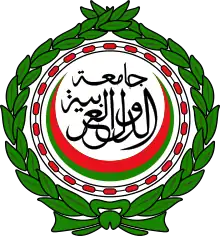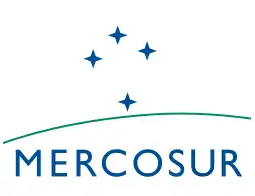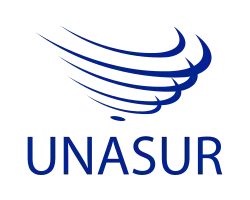Venezuela
Venezuela (/ˌvɛnəˈzweɪlə/; American Spanish: [beneˈswela] (![]() listen)), officially the Bolivarian Republic of Venezuela (Spanish: República Bolivariana de Venezuela),[12] is a country on the northern coast of South America, consisting of a continental landmass and many islands and islets in the Caribbean Sea. It has a territorial extension of 916,445 km2 (353,841 sq mi) and the population of Venezuela was estimated at 28 million in 2019.[7] The capital and largest urban agglomeration is the city of Caracas.
listen)), officially the Bolivarian Republic of Venezuela (Spanish: República Bolivariana de Venezuela),[12] is a country on the northern coast of South America, consisting of a continental landmass and many islands and islets in the Caribbean Sea. It has a territorial extension of 916,445 km2 (353,841 sq mi) and the population of Venezuela was estimated at 28 million in 2019.[7] The capital and largest urban agglomeration is the city of Caracas.
Bolivarian Republic of Venezuela | |
|---|---|
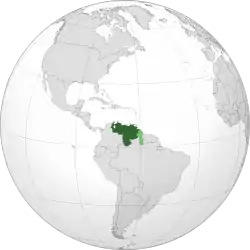 Land controlled by Venezuela shown in dark green; claimed but uncontrolled land shown in light green. | |
| Capital and largest city | Caracas 10°30′N 66°55′W |
| Official languages | Spanish[b] |
| Recognized regional languages | |
| Ethnic groups (2011)[1] |
|
| Religion (2012)[2] | 91% Christianity —71% Roman Catholic —17% Protestant —3% Other Christian 8% No religion 1% Other religions |
| Demonym(s) | Venezuelan |
| Government | Federal dominant-party presidential constitutional republic |
| |
| Delcy Rodríguez (constitutional position disputed) | |
| Legislature | National Assembly |
| Independence | |
• from Spain | 5 July 1811 |
• from Gran Colombia | 13 January 1830 |
• Recognized | 29 March 1845 |
• Admitted to the United Nations | 15 November 1945 |
| 20 December 1999[4] | |
| Area | |
• Total | 916,445 km2 (353,841 sq mi) (32nd) |
• Water (%) | 3.2%[d] |
| Population | |
• 2018 estimate | 28,067,000 (IMF)[7] (45th) |
• Density | 33.74/km2 (87.4/sq mi) (181st) |
| GDP (PPP) | 2019 estimate |
• Total | |
• Per capita | |
| GDP (nominal) | 2020 estimate |
• Total | |
• Per capita | |
| Gini (2013) | medium |
| HDI (2019) | high · 113th |
| Currency | (VES) |
| Time zone | UTC−4 (VET) |
| Date format | dd/mm/yyyy (CE) |
| Driving side | right |
| Calling code | +58 |
| ISO 3166 code | VE |
| Internet TLD | .ve |
| |
The continental territory is bordered on the north by the Caribbean Sea and the Atlantic Ocean, on the west by Colombia, Brazil on the south, Trinidad and Tobago to the north-east and on the east by Guyana. The Venezuelan government maintains a claim against Guyana to Guayana Esequiba.[13] Venezuela is a federal presidential republic consisting of 23 states, the Capital District and federal dependencies covering Venezuela's offshore islands. Venezuela is among the most urbanized countries in Latin America;[14][15] the vast majority of Venezuelans live in the cities of the north and in the capital.
The territory of Venezuela was colonized by Spain in 1522 amid resistance from indigenous peoples. In 1811, it became one of the first Spanish-American territories to declare independence from the Spanish, and to form part, as a department, of the first federal Republic of Colombia (historiographically known as Gran Colombia). It separated as a full sovereign country in 1830. During the 19th century, Venezuela suffered political turmoil and autocracy, remaining dominated by regional military dictators until the mid-20th century. Since 1958, the country has had a series of democratic governments, as an exception where most of the region was ruled by military dictatorships, and the period was characterized by economic prosperity. Economic shocks in the 1980s and 1990s led to major political crises and widespread social unrest, including the deadly Caracazo riots of 1989, two attempted coups in 1992, and the impeachment of a President for embezzlement of public funds charges in 1993. The collapse in confidence in the existing parties saw the 1998 Venezuelan presidential election, the catalyst for the Bolivarian Revolution, which began with a 1999 Constituent Assembly, where a new Constitution of Venezuela was imposed. The government populist social welfare policies were bolstered by soaring oil prices,[16] temporarily increasing social spending,[17] and reducing economic inequality and poverty in the early years of the regime.[22] The 2013 Venezuelan presidential election was widely disputed leading to widespread protest, which triggered another nationwide crisis that continues to this day.[23]
Venezuela is a developing country and ranks 113th on the Human Development Index. It has the world's largest known oil reserves and has been one of the world's leading exporters of oil. Previously, the country was an underdeveloped exporter of agricultural commodities such as coffee and cocoa, but oil quickly came to dominate exports and government revenues. The excesses and poor policies of the incumbent government led to the collapse of Venezuela's entire economy.[24][25] The country struggles with record hyperinflation,[26][27] shortages of basic goods,[28] unemployment,[29] poverty,[30] disease, high child mortality, malnutrition, severe crime and corruption. These factors have precipitated the Venezuelan migrant crisis where more than three million people have fled the country.[31] By 2017, Venezuela was declared to be in default regarding debt payments by credit rating agencies.[32][33] The crisis in Venezuela has contributed to a rapidly deteriorating human rights situation, including increased abuses such as torture, arbitrary imprisonment, extrajudicial killings and attacks on human rights advocates. Venezuela is a charter member of the UN, OAS, UNASUR, ALBA, Mercosur, LAIA and OEI.
Etymology
According to the most popular and accepted version, in 1499, an expedition led by Alonso de Ojeda visited the Venezuelan coast. The stilt houses in the area of Lake Maracaibo reminded the Italian navigator, Amerigo Vespucci, of the city of Venice, Italy, so he named the region Veneziola, or "Little Venice".[34] The Spanish version of Veneziola is Venezuela.[35]
Martín Fernández de Enciso, a member of the Vespucci and Ojeda crew, gave a different account. In his work Summa de geografía, he states that the crew found indigenous people who called themselves the Veneciuela. Thus, the name "Venezuela" may have evolved from the native word.[36]
Previously, the official name was Estado de Venezuela (1830–1856), República de Venezuela (1856–1864), Estados Unidos de Venezuela (1864–1953), and again República de Venezuela (1953–1999).
History
Pre-Columbian history

Evidence exists of human habitation in the area now known as Venezuela from about 15,000 years ago. Leaf-shaped tools from this period, together with chopping and plano-convex scraping implements, have been found exposed on the high riverine terraces of the Rio Pedregal in western Venezuela.[37] Late Pleistocene hunting artifacts, including spear tips, have been found at a similar series of sites in northwestern Venezuela known as "El Jobo"; according to radiocarbon dating, these date from 13,000 to 7,000 BC.[38]
It is not known how many people lived in Venezuela before the Spanish conquest; it has been estimated at around one million.[39] In addition to indigenous peoples known today, the population included historical groups such as the Kalina (Caribs), Auaké, Caquetio, Mariche, and Timoto–Cuicas. The Timoto–Cuica culture was the most complex society in Pre-Columbian Venezuela, with pre-planned permanent villages, surrounded by irrigated, terraced fields. They also stored water in tanks.[40] Their houses were made primarily of stone and wood with thatched roofs. They were peaceful, for the most part, and depended on growing crops. Regional crops included potatoes and ullucos.[41] They left behind works of art, particularly anthropomorphic ceramics, but no major monuments. They spun vegetable fibers to weave into textiles and mats for housing. They are credited with having invented the arepa, a staple in Venezuelan cuisine.[42]
After the conquest, the population dropped markedly, mainly through the spread of new infectious diseases from Europe.[39] Two main north–south axes of pre-Columbian population were present, who cultivated maize in the west and manioc in the east.[39] Large parts of the llanos were cultivated through a combination of slash and burn and permanent settled agriculture.[39]
Colonization
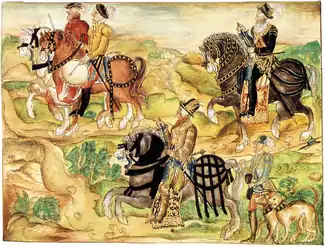
In 1498, during his third voyage to the Americas, Christopher Columbus sailed near the Orinoco Delta and landed in the Gulf of Paria.[43] Amazed by the great offshore current of freshwater which deflected his course eastward, Columbus expressed in a letter to Isabella and Ferdinand that he must have reached Heaven on Earth (terrestrial paradise):
Great signs are these of the Terrestrial Paradise, for the site conforms to the opinion of the holy and wise theologians whom I have mentioned. And likewise, the [other] signs conform very well, for I have never read or heard of such a large quantity of fresh water being inside and in such close proximity to salt water; the very mild temperateness also corroborates this; and if the water of which I speak does not proceed from Paradise then it is an even greater marvel, because I do not believe such a large and deep river has ever been known to exist in this world.[44]
Spain's colonization of mainland Venezuela started in 1522, establishing its first permanent South American settlement in the present-day city of Cumaná. In the 16th century, Venezuela was contracted as a concession by the King of Spain to the German Welser banking family (Klein-Venedig, 1528–1546). Native caciques (leaders) such as Guaicaipuro (c. 1530–1568) and Tamanaco (died 1573) attempted to resist Spanish incursions, but the newcomers ultimately subdued them; Tamanaco was put to death by order of Caracas' founder, Diego de Losada.[45]
In the 16th century, during the Spanish colonization, indigenous peoples such as many of the Mariches, themselves descendants of the Kalina, converted to Roman Catholicism. Some of the resisting tribes or leaders are commemorated in place names, including Caracas, Chacao and Los Teques. The early colonial settlements focused on the northern coast,[39] but in the mid-18th century, the Spanish pushed farther inland along the Orinoco River. Here, the Ye'kuana (then known as the Makiritare) organized serious resistance in 1775 and 1776.[46]
Spain's eastern Venezuelan settlements were incorporated into New Andalusia Province. Administered by the Royal Audiencia of Santo Domingo from the early 16th century, most of Venezuela became part of the Viceroyalty of New Granada in the early 18th century, and was then reorganized as an autonomous Captaincy General starting in 1777. The town of Caracas, founded in the central coastal region in 1567, was well-placed to become a key location, being near the coastal port of La Guaira whilst itself being located in a valley in a mountain range, providing defensive strength against pirates and a more fertile and healthy climate.[47]
Independence and 19th century
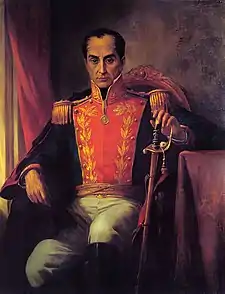
After a series of unsuccessful uprisings, Venezuela, under the leadership of Francisco de Miranda, a Venezuelan marshal who had fought in the American Revolution and the French Revolution, declared independence as the First Republic of Venezuela on 5 July 1811.[48] This began the Venezuelan War of Independence. A devastating earthquake that struck Caracas in 1812, together with the rebellion of the Venezuelan llaneros, helped bring down the republic.[49] Simón Bolívar, new leader of the independentist forces, launched his Admirable Campaign in 1813 from New Granada, retaking most of the territory and being proclaimed as El Libertador ("The Liberator"). A second Venezuelan republic was proclaimed on 7 August 1813, but lasted only a few months before being crushed at the hands of royalist caudillo José Tomás Boves and his personal army of llaneros.[50]
The end of the French invasion of homeland Spain in 1814 allowed the preparation of a large expeditionary force to the American provinces under general Pablo Morillo, with the goal to regain the lost territory in Venezuela and New Granada. As the war reached a stalemate on 1817, Bolívar reestablished the Third Republic of Venezuela on the territory still controlled by the patriots, mainly in the Guayana and Llanos regions. This republic was short-lived as only two years later, during the Congress of Angostura of 1819, the union of Venezuela with New Granada was decreed to form the Republic of Colombia (historiographically Republic of Gran Colombia). The war continued for some years, until full victory and sovereignty was attained after Bolívar, aided by José Antonio Páez and Antonio José de Sucre, won the Battle of Carabobo on 24 June 1821.[51] On 24 July 1823, José Prudencio Padilla and Rafael Urdaneta helped seal Venezuelan independence with their victory in the Battle of Lake Maracaibo.[52] New Granada's congress gave Bolívar control of the Granadian army; leading it, he liberated several countries and founded the Republic of Colombia (Gran Colombia).[51]

Sucre, who won many battles for Bolívar, went on to liberate Ecuador and later become the second president of Bolivia. Venezuela remained part of Gran Colombia until 1830, when a rebellion led by Páez allowed the proclamation of a newly independent Venezuela; Páez became the first president of the new State of Venezuela.[53] Between one-quarter and one-third of Venezuela's population was lost during these two decades of warfare (including perhaps one-half of the white population),[54] which by 1830, was estimated at about 800,000.[55]
The colors of the Venezuelan flag are yellow, blue, and red: the yellow stands for land wealth, the blue for the sea that separates Venezuela from Spain, and the red for the blood shed by the heroes of independence.[56]
Slavery in Venezuela was abolished in 1854.[55] Much of Venezuela's 19th-century history was characterized by political turmoil and dictatorial rule, including the Independence leader José Antonio Páez, who gained the presidency three times and served a total of 11 years between 1830 and 1863. This culminated in the Federal War (1859–1863), a civil war in which hundreds of thousands died in a country with a population of not much more than a million people. In the latter half of the century, Antonio Guzmán Blanco, another caudillo, served a total of 13 years between 1870 and 1887, with three other presidents interspersed.
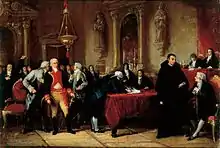
In 1895, a longstanding dispute with Great Britain about the territory of Guayana Esequiba, which Britain claimed as part of British Guiana and Venezuela saw as Venezuelan territory, erupted into the Venezuela Crisis of 1895. The dispute became a diplomatic crisis when Venezuela's lobbyist, William L. Scruggs, sought to argue that British behavior over the issue violated the United States' Monroe Doctrine of 1823, and used his influence in Washington, D.C., to pursue the matter. Then, U.S. president Grover Cleveland adopted a broad interpretation of the doctrine that did not just simply forbid new European colonies, but declared an American interest in any matter within the hemisphere.[57] Britain ultimately accepted arbitration, but in negotiations over its terms was able to persuade the U.S. on many of the details. A tribunal convened in Paris in 1898 to decide the issue and in 1899 awarded the bulk of the disputed territory to British Guiana.[58]
In 1899, Cipriano Castro, assisted by his friend Juan Vicente Gómez, seized power in Caracas, marching an army from his base in the Andean state of Táchira. Castro defaulted on Venezuela's considerable foreign debts and declined to pay compensation to foreigners caught up in Venezuela's civil wars. This led to the Venezuela Crisis of 1902–1903, in which Britain, Germany and Italy imposed a naval blockade of several months before international arbitration at the new Permanent Court of Arbitration in The Hague was agreed. In 1908, another dispute broke out with the Netherlands, which was resolved when Castro left for medical treatment in Germany and was promptly overthrown by Juan Vicente Gómez (1908–1935).
20th century
.svg.png.webp)
The discovery of massive oil deposits in Lake Maracaibo during World War I[59] proved to be pivotal for Venezuela and transformed the basis of its economy from a heavy dependence on agricultural exports. It prompted an economic boom that lasted into the 1980s; by 1935, Venezuela's per capita gross domestic product was Latin America's highest.[60] Gómez benefited handsomely from this, as corruption thrived, but at the same time, the new source of income helped him centralize the Venezuelan state and develop its authority.
He remained the most powerful man in Venezuela until his death in 1935, although at times he ceded the presidency to others. The gomecista dictatorship (1935–1945) system largely continued under Eleazar López Contreras, but from 1941, under Isaías Medina Angarita, was relaxed. Angarita granted a range of reforms, including the legalization of all political parties. After World War II, immigration from Southern Europe (mainly from Spain, Italy, Portugal, and France) and poorer Latin American countries markedly diversified Venezuelan society.
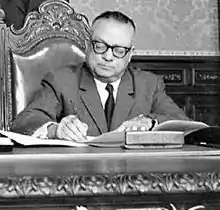
In 1945, a civilian-military coup overthrew Medina Angarita and ushered in a three-year period of democratic rule (1945–1948) under the mass membership party Democratic Action, initially under Rómulo Betancourt, until Rómulo Gallegos won the 1947 Venezuelan presidential election (generally believed to be the first free and fair elections in Venezuela). Gallegos governed until overthrown by a military junta led by the triumvirate Luis Felipe Llovera Páez, Marcos Pérez Jiménez, and Gallegos' Defense Minister, Carlos Delgado Chalbaud, in the 1948 Venezuelan coup d'état.
The most powerful man in the military junta (1948–1958) was Pérez Jiménez (though Chalbaud was its titular president) and was suspected of being behind the death in office of Chalbaud, who died in a bungled kidnapping in 1950. When the junta unexpectedly lost the election it held in 1952, it ignored the results and Pérez Jiménez was installed as president, where he remained until 1958. The expansion of the Venezuelan economy in this period was based on the indebtedness of the Venezuelan nation and that was one of the causes of the economic crisis in Venezuela in the 1960s,[61] in which important projects such as the Urban Center El Recreo de Marcel Brauer on Avenida Casanova in Sabana Grande district were paralyzed.[62]
During the years of Pérez Jiménez's administration, the State intervened in areas of the economy that were traditionally carried out by private companies. The Pérez Jiménez government was characterized by its state capitalism and not by liberal capitalism. It was an antecedent of the populist and paternalistic economic regime of the later democratic regimes.[63] The national private entrepreneurship increasingly had less space to grow and prosper. The State was the great capitalist in the Venezuela of Pérez Jiménez and was the largest national shareholder of major hotel chains such as Sheraton.[64]
In the government of Pérez Jiménez, Venezuela's debt grew more than 25 times and went from 175 million to more than 4,500 million bolivares in just 5 years (approximately 15 billion dollars in 2018). The malaise over the debts of Venezuela reached the barracks and the national business. Pérez Jiménez responded that: "there is no debt, but commitments". The Finance Minister failed to convince Pérez Jiménez to order the cancellation of debts.[65] As of 14 January 1958, the Venezuelan business community decided to divorce itself completely from the regime, nine days before the collapse of the government.[61] The military dictator Pérez Jiménez was forced out on 23 January 1958.[66] In an effort to consolidate a young democracy, the three major political parties (Acción Democrática (AD), COPEI and Unión Republicana Democrática (URD), with the notable exception of the Communist Party of Venezuela) signed the Puntofijo Pact power-sharing agreement. The two first parties would dominate the political landscape for four decades.
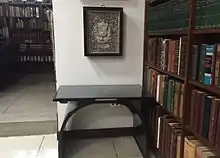
During the presidencies of Rómulo Ernesto Betancourt Bello (1959–1964, his second time) and Raúl Leoni Otero (1964–1969) in the 1960s, substantial guerilla movements occurred, including the Armed Forces of National Liberation and the Revolutionary Left Movement, which had split from AD in 1960. Most of these movements laid down their arms under Rafael Caldera's first presidency (1969–1974); Caldera had won the 1968 election for COPEI, being the first time a party other than Democratic Action took the presidency through a democratic election. The new democratic order had its antagonists. Betancourt suffered an attack planned by the Dominican dictator Rafael Trujillo in 1960, and the leftists excluded from the Pact initiated an armed insurgency by organizing themselves in the Armed Forces of National Liberation, sponsored by the Communist Party and Fidel Castro. In 1962 they tried to destabilize the military corps, with failed revolts in Carúpano and Puerto Cabello. At the same time, Betancourt promoted a foreign policy, the Betancourt Doctrine, in which he only recognized elected governments by popular vote.
As a result of the debt that Marcos Pérez Jiménez had left, an economic adjustment program was necessary in Venezuela. The Economic Recovery Plan of 1960 was formulated by Tomás Enrique Carrillo Batalla. The construction industry was revitalized through the "rediscount" of the Central Bank of Venezuela. The Economic Recovery Plan fulfilled its objectives and in 1964, Venezuela was able to return to an anchored exchange rate, with free purchase and sale of foreign currency. This system lasted until the Venezuelan Black Friday of 1983, although the model was already running out at the end of the seventies.[67] The consolidation of the democratic system and the dissipation of fears of political radicalization of the country contributed to normalize the demand for foreign currency, stabilizing the parallel exchange rate.
For much of the period between 1950 and 1973, the Venezuelan economy was characterized by its stability and sustained strength, factors that contributed decisively to being able to maintain a fixed exchange rate without major inconveniences. In the period of Carlos Andrés Pérez (1974–1979, his first time as president), as a result of the Arab-Israeli war (the Yom Kippur War), the average price of a barrel of oil went from 3.71 to 10.53 dollars and continued to rise to exceed 29 dollars in 1981.[67] The income of the public sector went from 18,960 million bolivars in 1973 to 45.564 million in 1974. The economic bonanza also had the characteristics of an economic bubble, but Venezuelans remember the "Ta barato, dame dos".[68][69] The increased inflow of funds to savings and loan entities and mortgage banks allowed an increase in the mortgage loan portfolio, which also tripled. In general, Venezuela was a prosperous country in the governments of Rómulo Betancourt (1945 – c. 1948; 1959–1964), Rafael Caldera (1969–1974; 1994 – c. 1999) and Carlos Andrés Pérez (1974–1979; 1989 – c. 1993). In 1975 the iron industry was nationalized and the following year the oil industry, creating Petróleos de Venezuela, S.A. (PDVSA). Both Caldera and Pérez partially broke with the Betancourt Doctrine.
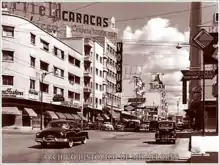
The election in 1973 of Carlos Andrés Pérez coincided with an oil crisis, in which Venezuela's income exploded as oil prices soared; oil industries were nationalized in 1976. This led to massive increases in public spending, but also increases in external debts, which continued into the 1980s when the collapse of oil prices during the 1980s crippled the Venezuelan economy. As the government started to devalue the currency in February 1983 to face its financial obligations, Venezuelans' real standards of living fell dramatically. A number of failed economic policies and increasing corruption in government led to rising poverty and crime, worsening social indicators, and increased political instability.[70]
During the presidency of Luis Herrera Campins (1979–1984), important infrastructure works were completed, such as the Parque Central Complex (which became the largest housing complex and the tallest towers in Latin America), Teresa Carreño Cultural Complex (the largest cultural center in South America at that time), the Brígido Iriarte Stadium and the United Nations Park. Most of these works had been previously planned.[68] Until the mid-eighties, the Venezuelan economy showed a very positive behavior, characterized by the absence of internal or external imbalances, high economic growth, largely due to the sustained and very high gross fixed investment of those years, 10 under unemployment and great price stability. This translated into sustained increases in the average real wage and an improvement in the condition of life.[67]
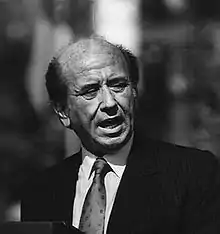
The bolivar was devalued in February 1983, unleashing a strong economic crisis, which hit investments in the most important financial centers of the Venezuelan capital, such as Sabana Grande. In the government of Jaime Lusinchi (1984–1989), an attempt was made to solve the problem. Unfortunately, the measures failed. After a long period of accelerated economic expansion that lasts for six decades (value of the stock of homes by families), an extreme higher value is reached towards 1982. From this historical value begins then a systematic fall that mounts to 26 hundred up to 2006, and that configures a genuine unique experience in contemporary economic life.[71] However, the economic deactivation of the country had begun to show its first signs in 1978.[72]
In the 1980s, the Presidential Commission for State Reform (COPRE) emerged as a mechanism of political innovation. Venezuela was preparing for the decentralization of its political system and the diversification of its economy, reducing the large size of the State. The COPRE operated as an innovation mechanism, also by incorporating issues into the political agenda that were generally excluded from public deliberation by the main actors of the Venezuelan democratic system. The most discussed topics were incorporated into the public agenda: decentralization, political participation, municipalization, judicial oder reforms and the role of the State in a new economic strategy. Unfortunately, the social reality of the country made the changes difficult to apply.[72]
Economic crises in the 1980s and 1990s led to a political crisis in which hundreds died in the Caracazo riots of 1989 during the presidency of Carlos Andres Pérez (1989–1993, his second time), two attempted coups d'état in 1992 (February and November) by Hugo Chávez,[73] and the impeachment of President Carlos Andrés Pérez (re-elected in 1988) for corruption in 1993 and the interim presidency of Ramón José Velásquez (1993–1994). Coup leader Hugo Chávez was pardoned in March 1994 by president Rafael Caldera (1994–1999, his second time), with a clean slate and his political rights reinstated. This let him later get the presidency continuously from 1999 until his death in 2013, winning the elections of 1998, 2000, 2006 and 2012 and the presidential referendum of 2004, with the only exception in 2002 of Pedro Carmona Estanga as a two-day de facto government and Diosdado Cabello Rondón as a few-hours interim president.
Bolivarian government: 1999–present
The Bolivarian Revolution refers to a left-wing populism social movement and political process in Venezuela led by Venezuelan president Hugo Chávez, who founded the Fifth Republic Movement in 1997 and the United Socialist Party of Venezuela in 2007. The "Bolivarian Revolution" is named after Simón Bolívar, an early 19th-century Venezuelan and Latin American revolutionary leader, prominent in the Spanish American wars of independence in achieving the independence of most of northern South America from Spanish rule. According to Chávez and other supporters, the "Bolivarian Revolution" seeks to build a mass movement to implement Bolivarianism—popular democracy, economic independence, equitable distribution of revenues, and an end to political corruption—in Venezuela. They interpret Bolívar's ideas from a populist perspective, using socialist rhetoric.
Hugo Chávez: 1999–2013
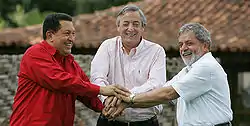
A collapse in confidence in the existing parties led to Chávez being elected president in 1998 and the subsequent launch of a "Bolivarian Revolution", beginning with a 1999 Constituent Assembly to write a new Constitution of Venezuela. Chávez also initiated Bolivarian missions, programs aimed at helping the poor.[74]
In April 2002, Chávez was briefly ousted from power in the 2002 Venezuelan coup d'état attempt following popular demonstrations by his opponents,[75] but he returned to power after two days as a result of demonstrations by poor Chávez supporters in Caracas and actions by the military.[76][77]
Chávez also remained in power after an all-out national strike that lasted from December 2002 to February 2003, including a strike/lockout in the state oil company PDVSA.[78] The strike produced severe economic dislocation, with the country's GDP falling 27% during the first four months of 2003, and costing the oil industry $13.3 billion.[79] Capital flight before and during the strike led to the reimposition of currency controls (which had been abolished in 1989), managed by the CADIVI agency. In the subsequent decade, the government was forced into several currency devaluations.[80][81][82][83][84] These devaluations have done little to improve the situation of the Venezuelan people who rely on imported products or locally produced products that depend on imported inputs while dollar-denominated oil sales account for the vast majority of Venezuela's exports.[85] According to Sebastian Boyd writing at Bloomberg News, the profits of the oil industry have been lost to "social engineering" and corruption, instead of investments needed to maintain oil production.[86]
Chávez survived several further political tests, including an August 2004 recall referendum. He was elected for another term in December 2006 and re-elected for a third term in October 2012. However, he was never sworn in for his third period, due to medical complications. Chávez died on 5 March 2013 after a nearly two-year fight with cancer.[87] The presidential election that took place on Sunday, 14 April 2013, was the first since Chávez took office in 1999 in which his name did not appear on the ballot.[88]
Nicolás Maduro: 2013–present
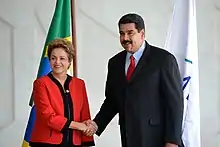
Poverty and inflation began to increase into the 2010s.[89] Nicolás Maduro was elected in 2013 after the death of Chavez. Chavez picked Maduro as his successor and appointed him vice president in 2013. Maduro was elected president in a shortened election in 2013 following Chavez's death.[83][90][91]
Nicolás Maduro has been the president of Venezuela since 14 April 2013, after winning the second presidential election after Chávez's death, with 50.61% of the votes against the opposition's candidate Henrique Capriles Radonski who had 49.12% of the votes. The Democratic Unity Roundtable contested his election as fraud and as a violation of the constitution. An audit of 56% of the vote showed no discrepancies,[92] and the Supreme Court of Venezuela ruled that under Venezuela's Constitution, Nicolás Maduro is the legitimate president and was invested as such by the Venezuelan National Assembly (Asamblea Nacional).[93][94][95] Opposition leaders and some international media consider the government of Maduro to be a dictatorship.[96][97][98][99] Beginning in February 2014, hundreds of thousands of Venezuelans have protested over high levels of criminal violence, corruption, hyperinflation, and chronic scarcity of basic goods due to policies of the federal government.[100][101][102][103][104] Demonstrations and riots have left over 40 fatalities in the unrest between both Chavistas and opposition protesters,[105] and has led to the arrest of opposition leaders including Leopoldo López[105][106] and Antonio Ledezma.[107][108][109][110] Human rights groups have strongly condemned the arrest of Leopoldo López.[111] In the 2015 Venezuelan parliamentary election, the opposition gained a majority.[112]
Venezuela devalued its currency in February 2013 due to the rising shortages in the country,[84][113] which included those of milk, flour, and other necessities. This led to an increase in malnutrition, especially among children.[114][115] Venezuela's economy had become strongly dependent on the exportation of oil with crude accounting for 86% of exports,[116] and a high price per barrel to support social programs. Beginning in 2014 the price of oil plummeted from over $100/bbl to $40/bbl a year and a half later, this placed great pressure on the Venezuelan economy, which was no longer able to afford vast social programs. To counter the decrease in oil prices, the Venezuelan Government began taking more money from PDVSA, the state oil company, to meet budgets resulting in a lack of reinvestment in fields and employees. This has seen Venezuela's oil production decrease from its height of nearly 3 to 1 million barrels (480 to 160 thousand cubic metres) per day.[117][118][119][120] In 2014, Venezuela entered an economic recession.[121] In 2015, Venezuela had the world's highest inflation rate with the rate surpassing 100%, becoming the highest in the country's history.[122] In 2017, Donald Trump's administration imposed more economic sanctions against Venezuela's state-owned oil company PDVSA and Venezuelan officials.[123][124][125] Economic problems, as well as crime and corruption, were some of the main causes of the 2014–present Venezuelan protests.[126][127] Since 2015 nearly 2 million people have fled Venezuela.[128]
In January 2016, President Maduro decreed an "economic emergency" revealing the extent of the crisis and expanding his powers.[129] In July 2016, Colombian border crossings were temporarily opened to allow Venezuelans to purchase food and basic household and health items in Colombia.[130] In September 2016, a study published in the Spanish-language Diario Las Américas[131] indicated that 15% of Venezuelans are eating "food waste discarded by commercial establishments".
Close to 200 riots had occurred in Venezuelan prisons by October 2016, according to Una Ventana a la Libertad, an advocacy group for better prison conditions. The father of an inmate at Táchira Detention Center in Caracas alleged that his son was cannibalized by other inmates during a month-long riot, a claim corroborated by an anonymous police source but denied by the Minister of Correctional Affairs.[132]
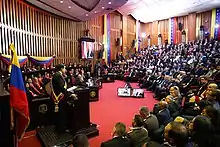
In 2017, Venezuela experienced a constitutional crisis in the country. In March 2017, opposition leaders branded President Nicolas Maduro a dictator after the Maduro-aligned Supreme Tribunal, which had been overturning most National Assembly decisions since the opposition took control of the body, took over the functions of the assembly, pushing a lengthy political standoff to new heights.[96] However, the Supreme Court quickly backed down and reversed its decision on 1 April 2017. A month later, President Maduro announced the 2017 Venezuelan Constituent Assembly election and on 30 August 2017, the 2017 Constituent National Assembly was elected into office and quickly stripped the National Assembly of its powers.
In December 2017, President Maduro declared that leading opposition parties would be barred from taking part in following year's presidential vote after they boycotted mayoral polls.[133]
Maduro won the 2018 election with 67.8% of the vote. The result was challenged by countries including Argentina, Chile, Colombia, Brazil, Canada, Germany, France and the United States who deemed it fraudulent and moved to recognize Juan Guaidó as president.[134][135][136][137] Other countries including Cuba, China, Russia, Turkey, and Iran have continued to recognize Maduro as president,[138][139] although China, facing financial pressure over its position, has reportedly begun hedging its position by decreasing loans given, cancelling joint ventures, and signaling willingness to work with all parties.[140] A Chinese Ministry of Foreign Affairs spokeswoman denied the reports, describing them as "false information".[141]
In January 2019 the Permanent Council of the Organization of American States (OAS) approved a resolution "to not recognize the legitimacy of Nicolas Maduro's new term as of the 10th of January of 2019,"[142] while the United Nations General Assembly formally recognized the Maduro government as the only legitimate representative of Venezuela at the United Nations[143] and in October 2019, Venezuela was elected to the United Nations Human Rights Council.[144]
In August 2019, United States President Donald Trump signed an executive order to impose a total economic embargo against Venezuela.[145] Later, in March 2020, the Trump administration indicted Maduro and several Venezuelan officials on charges of drug trafficking.[146]
In June 2020, a detailed report by Robert F. Kennedy Human Rights documented enforced disappearances in Venezuela, specifically those that occurred during the years 2018 and 2019. During the period, around 724 enforced disappearances of political detainees were reported. Venezuelan security forces have subjected victims that have disappeared to illegal interrogation processes accompanied by torture and cruel or inhuman treatment. Venezuela's Bolivarian regime has strategically used enforced disappearances to silence political opponents and other critical voices it deems a threat.[147][148]
Geography
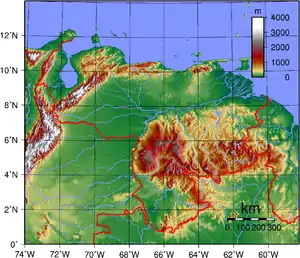
Venezuela is located in the north of South America; geologically, its mainland rests on the South American Plate. It has a total area of 916,445 km2 (353,841 sq mi) and a land area of 882,050 km2 (340,560 sq mi), making Venezuela the 33rd largest country in the world. The territory it controls lies between latitudes 0° and 13°N and longitudes 59° and 74°W.
Shaped roughly like a triangle, the country has a 2,800 km (1,700 mi) coastline in the north, which includes numerous islands in the Caribbean and the northeast borders the northern Atlantic Ocean. Most observers describe Venezuela in terms of four fairly well defined topographical regions: the Maracaibo lowlands in the northwest, the northern mountains extending in a broad east–west arc from the Colombian border along the northern Caribbean coast, the wide plains in central Venezuela, and the Guiana Highlands in the southeast.
The northern mountains are the extreme northeastern extensions of South America's Andes mountain range. Pico Bolívar, the nation's highest point at 4,979 m (16,335 ft), lies in this region. To the south, the dissected Guiana Highlands contain the northern fringes of the Amazon Basin and Angel Falls, the world's highest waterfall, as well as tepuis, large table-like mountains. The country's center is characterized by the llanos, which are extensive plains that stretch from the Colombian border in the far west to the Orinoco River delta in the east. The Orinoco, with its rich alluvial soils, binds the largest and most important river system of the country; it originates in one of the largest watersheds in Latin America. The Caroní and the Apure are other major rivers.
Venezuela borders Colombia to the west, Guyana to the east, and Brazil to the south. Caribbean islands such as Trinidad and Tobago, Grenada, Curaçao, Aruba, and the Leeward Antilles lie near the Venezuelan coast. Venezuela has territorial disputes with Guyana, formerly United Kingdom, largely concerning the Essequibo area and with Colombia concerning the Gulf of Venezuela. In 1895, after years of diplomatic attempts to solve the border dispute, the dispute over the Essequibo River border flared up. It was submitted to a "neutral" commission (composed of British, American, and Russian representatives and without a direct Venezuelan representative), which in 1899 decided mostly against Venezuela's claim.[149]
Venezuela's most significant natural resources are petroleum and natural gas, iron ore, gold, and other minerals. It also has large areas of arable land and water.

Climate
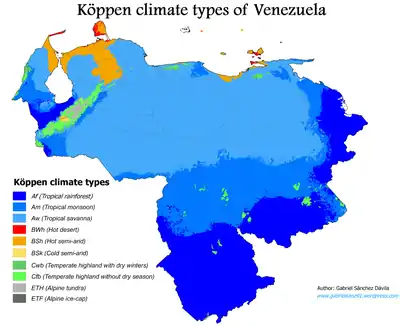
Venezuela is entirely located in the tropics over the Equator to around 12° N. Its climate varies from humid low-elevation plains, where average annual temperatures range as high as 35 °C (95.0 °F), to glaciers and highlands (the páramos) with an average yearly temperature of 8 °C (46.4 °F). Annual rainfall varies from 430 mm (16.9 in) in the semiarid portions of the northwest to over 1,000 mm (39.4 in) in the Orinoco Delta of the far east and the Amazonian Jungle in the south. The precipitation level is lower in the period from August through April. These periods are referred to as hot-humid and cold-dry seasons. Another characteristic of the climate is this variation throughout the country by the existence of a mountain range called "Cordillera de la Costa" which crosses the country from east to west. The majority of the population lives in these mountains.[151]

The country falls into four horizontal temperature zones based primarily on elevation, having tropical, dry, temperate with dry winters, and polar (alpine tundra) climates, amongst others.[152][153][154] In the tropical zone—below 800 m (2,625 ft)—temperatures are hot, with yearly averages ranging between 26 and 28 °C (78.8 and 82.4 °F). The temperate zone ranges between 800 and 2,000 m (2,625 and 6,562 ft) with averages from 12 to 25 °C (53.6 to 77.0 °F); many of Venezuela's cities, including the capital, lie in this region. Colder conditions with temperatures from 9 to 11 °C (48.2 to 51.8 °F) are found in the cool zone between 2,000 and 3,000 m (6,562 and 9,843 ft), especially in the Venezuelan Andes, where pastureland and permanent snowfield with yearly averages below 8 °C (46 °F) cover land above 3,000 meters (9,843 ft) in the páramos.
The highest temperature recorded was 42 °C (108 °F) in Machiques,[155] and the lowest temperature recorded was −11 °C (12 °F), it has been reported from an uninhabited high altitude at Páramo de Piedras Blancas (Mérida state),[156] even though no official reports exist, lower temperatures in the mountains of the Sierra Nevada de Mérida are known.
Biodiversity
.png.webp)
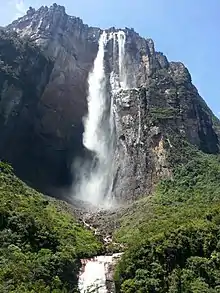
Venezuela lies within the Neotropical realm; large portions of the country were originally covered by moist broadleaf forests. One of 17 megadiverse countries,[157] Venezuela's habitats range from the Andes Mountains in the west to the Amazon Basin rainforest in the south, via extensive llanos plains and Caribbean coast in the center and the Orinoco River Delta in the east. They include xeric scrublands in the extreme northwest and coastal mangrove forests in the northeast.[151] Its cloud forests and lowland rainforests are particularly rich.[158]
Animals of Venezuela are diverse and include manatees, three-toed sloth, two-toed sloth, Amazon river dolphins, and Orinoco Crocodiles, which have been reported to reach up to 6.6 m (22 ft) in length. Venezuela hosts a total of 1,417 bird species, 48 of which are endemic.[159] Important birds include ibises, ospreys, kingfishers,[158] and the yellow-orange Venezuelan troupial, the national bird. Notable mammals include the giant anteater, jaguar, and the capybara, the world's largest rodent. More than half of Venezuelan avian and mammalian species are found in the Amazonian forests south of the Orinoco.[160]
For the fungi, an account was provided by R.W.G. Dennis[161] which has been digitized and the records made available on-line as part of the Cybertruffle Robigalia database.[162] That database includes nearly 3,900 species of fungi recorded from Venezuela, but is far from complete, and the true total number of fungal species already known from Venezuela is likely higher, given the generally accepted estimate that only about 7% of all fungi worldwide have so far been discovered.[163]
Among plants of Venezuela, over 25,000 species of orchids are found in the country's cloud forest and lowland rainforest ecosystems.[158] These include the flor de mayo orchid (Cattleya mossiae), the national flower. Venezuela's national tree is the araguaney, whose characteristic lushness after the rainy season led novelist Rómulo Gallegos to name it "[l]a primavera de oro de los araguaneyes" (the golden spring of the araguaneyes). The tops of the tepuis are also home to several carnivorous plants including the marsh pitcher plant, Heliamphora, and the insectivorous bromeliad, Brocchinia reducta.
Venezuela is among the top 20 countries in terms of endemism.[164] Among its animals, 23% of reptilian and 50% of amphibian species are endemic.[164] Although the available information is still very small, a first effort has been made to estimate the number of fungal species endemic to Venezuela: 1334 species of fungi have been tentatively identified as possible endemics of the country.[165] Some 38% of the over 21,000 plant species known from Venezuela are unique to the country.[164]
Environment
Venezuela is one of the 10 most biodiverse countries on the planet, yet it is one of the leaders of deforestation due to economic and political factors. Each year, roughly 287,600 hectares of forest are permanently destroyed and other areas are degraded by mining, oil extraction, and logging. Between 1990 and 2005, Venezuela officially lost 8.3% of its forest cover, which is about 4.3 million ha. In response, federal protections for critical habitat were implemented; for example, 20% to 33% of forested land is protected.[160] Venezuela had a 2019 Forest Landscape Integrity Index mean score of 8.78/10, ranking it 19th globally out of 172 countries.[168] The country's biosphere reserve is part of the World Network of Biosphere Reserves; five wetlands are registered under the Ramsar Convention.[169] In 2003, 70% of the nation's land was under conservation management in over 200 protected areas, including 43 national parks.[170] Venezuela's 43 national parks include Canaima National Park, Morrocoy National Park, and Mochima National Park. In the far south is a reserve for the country's Yanomami tribes. Covering 32,000 square miles (82,880 square kilometres), the area is off-limits to farmers, miners, and all non-Yanomami settlers.
Venezuela was one of the few countries that did not enter an INDC at COP21.[171][172] Many terrestrial ecosystems are considered endangered, specially the dry forest in the northern regions of the country and the coral reefs in the Caribbean coast.[166][173][174]
Hydrography
The country is made up of three river basins: the Caribbean Sea, the Atlantic Ocean and Lake Valencia, which forms an endorheic basin.[175]
On the Atlantic side it drains most of Venezuela's river waters. The largest basin in this area is the extensive Orinoco basin[176] whose surface area, close to one million km2, is greater than that of the whole of Venezuela, although it has a presence of 65% in the country. The size of this basin - similar to that of the Danube - makes it the third largest in South America, and it gives rise to a flow of some 33,000 m³/s, making the Orinoco the third largest in the world, and also one of the most valuable from the point of view of renewable natural resources. The Rio or Brazo Casiquiare is unique in the world, as it is a natural derivation of the Orinoco that, after some 500 km in length, connects it to the Negro River, which in turn is a tributary of the Amazon. The Orinoco receives directly or indirectly rivers such as the Ventuari, the Caura, the Caroní, the Meta, the Arauca, the Apure and many others. Other Venezuelan rivers that empty into the Atlantic are the waters of the San Juan and Cuyuní basins. Finally, there is the Amazon River, which receives the Guainía, the Negro and others. Other basins are the Gulf of Paria and the Esequibo River.

The second most important watershed is the Caribbean Sea. The rivers of this region are usually short and of scarce and irregular flow, with some exceptions such as the Catatumbo, which originates in Colombia and drains into the Maracaibo Lake basin. Among the rivers that reach the Maracaibo lake basin are the Chama, the Escalante, the Catatumbo, and the contributions of the smaller basins of the Tocuyo, Yaracuy, Neverí and Manzanares rivers.
A minimum drains to the Lake Valencia basin.[177] Of the total extension of the rivers, a total of 5400 km are navigable. Other rivers worth mentioning are the Apure, Arauca, Caura, Meta, Barima, Portuguesa, Ventuari and Zulia, among others.
The country's main lakes are Lake Maracaibo[178] -the largest in South America- open to the sea through the natural channel, but with fresh water, and Lake Valencia with its endorheic system. Other noteworthy bodies of water are the Guri reservoir, the Altagracia lagoon, the Camatagua reservoir and the Mucubají lagoon in the Andes. Navigation in Lake Maracaibo through the natural channel is useful for the mobilization of oil resources.
Relief
The Venezuelan natural landscape is the product of the interaction of tectonic plates that since the Paleozoic have contributed to its current appearance. On the formed structures, seven physical-natural units have been modeled, differentiated in their relief and in their natural resources.
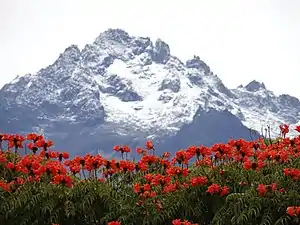
The relief of Venezuela has the following characteristics: coastline with several peninsulas and islands, adenas of the Andes mountain range (north and northwest), Lake Maracaibo (between the chains, on the coast); Orinoco river delta, region of peneplains and plateaus (tepui, east of the Orinoco) that together form the Guyanas massif (plateaus, southeast of the country).
The oldest rock formations in South America are found in the complex basement of the Guyanas highlands and in the crystalline line of the Maritime and Cordillera massifs in Venezuela. The Venezuelan part of the Guyanas Altiplano consists of a large granite block of gneiss and other crystalline Archean rocks, with underlying layers of sandstone and shale clay. The core of granite and Cordillera is, to a large extent, flanked by sedimentary layers from the Cretaceous, folded in an anticline structure. Between these orographic systems there are plains covered with tertiary and quaternary layers of gravels, sands and clayey marls. The depression in which are lagoons and lakes, among which is that of Maracaibo, presents, on the surface, alluvial deposits from the Quaternary, on layers of the Cretaceous and Tertiary particularly important, because of them oil infiltrations emerge.
- The coasts
They present a landscape with intermountain depressions (separated by mountains), mountainous areas, a massif and an island group.
- Lara-Falcón-Yaracuy System
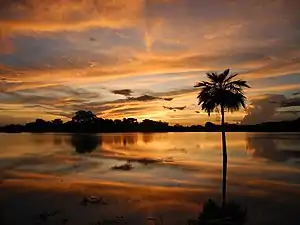
The reliefs of mountain ranges contrast with those of the peninsula, coastal plains and intermountain depressions.
- Lake Maracaibo Basin
The basin of the lake and the plains of the Gulf of Venezuela make up two plains: the northern one, drier, and the southern one, humid and with swamps.[179]
- The Andes
The corpulent volumes of mountain ranges and mountain ranges predominate, as well as intramontane valleys (located within the mountains).
- The plains
They form extensive sedimentary basins, with a predominantly flat relief,[180] except the eastern Llanos, which show plateaus, and the Unare depression, formed by the erosion of the mesa.
.jpeg.webp)
- Guiana Shield
It exhibits a varied relief, shaped by different rocks, orogenic events and erosion over millions of years. That is why here there are peneplains, mountain ranges, foothills and the characteristic tepuis.[181]
- Orinoco Delta
With few contrasts, it builds a complex system of lands and waters, with varied sedimentary contributions and innumerable channels and islands.[182]
The morphology of the Venezuelan relief has largely determined the distribution of human settlements. Ignorance of the factors associated with relief has been one of the most important causes of natural disasters. The continuous landslides linked to the location of houses in areas of steep slopes, as well as the seasonal flooding of many human settlements located in the floodplains of the water courses are known.
Government and politics
Following the fall of Marcos Pérez Jiménez in 1958, Venezuelan politics were dominated by the Third Way Christian democratic COPEI and the center-left social democratic Democratic Action (AD) parties; this two-party system was formalized by the puntofijismo arrangement. Economic crises in the 1980s and 1990s led to a political crisis which resulted in hundreds dead in the Caracazo riots of 1989, two attempted coups in 1992, and impeachment of President Carlos Andrés Pérez for corruption in 1993. A collapse in confidence in the existing parties saw the 1998 election of Hugo Chávez, who had led the first of the 1992 coup attempts, and the launch of a "Bolivarian Revolution", beginning with a 1999 Constituent Assembly to write a new Constitution of Venezuela.
The opposition's attempts to unseat Chávez included the 2002 Venezuelan coup d'état attempt, the Venezuelan general strike of 2002–2003, and the Venezuelan recall referendum, 2004, all of which failed. Chávez was re-elected in December 2006 but suffered a significant defeat in 2007 with the narrow rejection of the 2007 Venezuelan constitutional referendum, which had offered two packages of constitutional reforms aimed at deepening the Bolivarian Revolution.
Two major blocs of political parties are in Venezuela: the incumbent leftist bloc United Socialist Party of Venezuela (PSUV), its major allies Fatherland for All (PPT) and the Communist Party of Venezuela (PCV), and the opposition bloc grouped into the electoral coalition Mesa de la Unidad Democrática. This includes A New Era (UNT) together with allied parties Project Venezuela, Justice First, Movement for Socialism (MAS) and others. Hugo Chávez, the central figure of the Venezuelan political landscape since his election to the presidency in 1998 as a political outsider, died in office in early 2013, and was succeeded by Nicolás Maduro (initially as interim president, before narrowly winning the 2013 Venezuelan presidential election).
The Venezuelan president is elected by a vote, with direct and universal suffrage, and is both head of state and head of government. The term of office is six years, and (as of 15 February 2009) a president may be re-elected an unlimited number of times. The president appoints the vice president and decides the size and composition of the cabinet and makes appointments to it with the involvement of the legislature. The president can ask the legislature to reconsider portions of laws he finds objectionable, but a simple parliamentary majority can override these objections.
The president may ask the National Assembly to pass an enabling act granting the ability to rule by decree in specified policy areas; this requires a two-thirds majority in the Assembly. Since 1959, six Venezuelan presidents have been granted such powers.
The unicameral Venezuelan parliament is the Asamblea Nacional ("National Assembly"). The number of members is variable – each state and the Capital district elect three representatives plus the result of dividing the state population by 1.1% of the total population of the country.[183] Three seats are reserved for representatives of Venezuela's indigenous peoples. For the 2011–2016 period the number of seats is 165.[184] All deputies serve five-year terms.
The voting age in Venezuela is 18 and older. Voting is not compulsory.[185]
The legal system of Venezuela belongs to the Continental Law tradition. The highest judicial body is the Supreme Tribunal of Justice or Tribunal Supremo de Justicia, whose magistrates are elected by parliament for a single two-year term. The National Electoral Council (Consejo Nacional Electoral, or CNE) is in charge of electoral processes; it is formed by five main directors elected by the National Assembly. Supreme Court president Luisa Estela Morales said in December 2009 that Venezuela had moved away from "a rigid division of powers" toward a system characterized by "intense coordination" between the branches of government. Morales clarified that each power must be independent adding that "one thing is separation of powers and another one is division".[186]
Suspension of constitutional rights
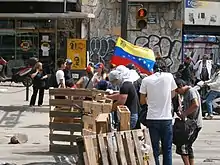
The 2015 parliamentary elections were held on 6 December 2015 to elect the 164 deputies and three indigenous representatives of the National Assembly. In 2014, a series of protest and demonstrations began in Venezuela, attributed to inflation, violence and shortages in Venezuela. The government has accused the protest of being motivated by fascists, opposition leaders, capitalism and foreign influence,[187] despite being largely peaceful.[188]
President Maduro acknowledged PSUV defeat, but attributed the opposition's victory to an intensification of an economic war. Despite this, Maduro said "I will stop by hook or by crook the opposition coming to power, whatever the costs, in any way".[189] In the following months, Maduro fulfilled his promise of preventing the democratically and constitutionally elected National Assembly from legislating. The first steps taken by PSUV and government were the substitution of the entire Supreme court a day after the Parliamentary Elections[190] contrary to the Constitution of Venezuela, acclaimed as a fraud by the majority of the Venezuelan and international press.[191][192][193][194] The Financial Times described the function of the Supreme Court in Venezuela as "rubber stamping executive whims and vetoing legislation".[195] The PSUV government used this violation to suspend several elected opponents,[196] ignoring again the Constitution of Venezuela. Maduro said that "the Amnesty law (approved by the Parliament) will not be executed" and asked the Supreme Court to declare it unconstitutional before the law was known.[197]
On 16 January 2016, Maduro approved an unconstitutional economic emergency decree,[198] relegating to his own figure the legislative and executive powers, while also holding judiciary power through the fraudulent designation of judges the day after the election on 6 December 2015.[190][191][192][193][194] From these events, Maduro effectively controls all three branches of government. On 14 May 2016, constitutional guarantees were in fact suspended when Maduro decreed the extension of the economic emergency decree for another 60 days and declared a State of Emergency,[199] which is a clear violation of the Constitution of Venezuela[200] in the Article 338th: "The approval of the extension of States of emergency corresponds to the National Assembly." Thus, constitutional rights in Venezuela are considered suspended in fact by many publications[201][202][203] and public figures.[204][205][206]
On 14 May 2016, the Organization of American States was considering the application of the Inter-American Democratic Charter[207] sanctions for non-compliance to its own constitution.
In March 2017, the Venezuelan Supreme Court took over law making powers from the National Assembly[208] but reversed its decision the following day.[209]
Foreign relations
.png.webp)
Throughout most of the 20th century, Venezuela maintained friendly relations with most Latin American and Western nations. Relations between Venezuela and the United States government worsened in 2002, after the 2002 Venezuelan coup d'état attempt during which the U.S. government recognized the short-lived interim presidency of Pedro Carmona. In 2015, Venezuela was declared a national security threat by U.S. president Barack Obama.[210][211][212] Correspondingly, ties to various Latin American and Middle Eastern countries not allied to the U.S. have strengthened. For example, Palestinian foreign minister Riyad al-Maliki declared in 2015 that Venezuela was his country's "most important ally".[213]
Venezuela seeks alternative hemispheric integration via such proposals as the Bolivarian Alternative for the Americas trade proposal and the newly launched Latin American television network teleSUR. Venezuela is one of five nations in the world—along with Russia, Nicaragua, Nauru, and Syria—to have recognized the independence of Abkhazia and South Ossetia. Venezuela was a proponent of OAS's decision to adopt its Anti-Corruption Convention[214] and is actively working in the Mercosur trade bloc to push increased trade and energy integration. Globally, it seeks a "multi-polar" world based on strengthened ties among undeveloped countries.

On 26 April 2017, Venezuela announced its intention to withdraw from the OAS.[215] Venezuelan Foreign Minister Delcy Rodríguez said that President Nicolás Maduro plans to publicly renounce Venezuela's membership on 27 April 2017. It will take two years for the country to formally leave. During this period, the country does not plan on participating in the OAS.[216]
Venezuela is involved in a long-standing disagreement about the control of the Guayana Esequiba area.
Venezuela may suffer a deterioration of its power in international affairs if the global transition to renewable energy is completed. It is ranked 151 out of 156 countries in the index of Geopolitical Gains and Losses after energy transition (GeGaLo).[217]
Military

The Bolivarian National Armed Forces of the Bolivarian Republic of Venezuela (Fuerza Armada Nacional Bolivariana, FANB) are the overall unified military forces of Venezuela. It includes over 320,150 men and women, under Article 328 of the Constitution, in 5 components of Ground, Sea and Air. The components of the Bolivarian National Armed Forces are: the Venezuelan Army, the Venezuelan Navy, the Venezuelan Air Force, the Venezuelan National Guard, and the Venezuelan National Militia.
As of 2008, a further 600,000 soldiers were incorporated into a new branch, known as the Armed Reserve. The president of Venezuela is the commander-in-chief of the national armed forces. The main roles of the armed forces are to defend the sovereign national territory of Venezuela, airspace, and islands, fight against drug trafficking, to search and rescue and, in the case of a natural disaster, civil protection. All male citizens of Venezuela have a constitutional duty to register for the military service at the age of 18, which is the age of majority in Venezuela.
Law and crime
.png.webp)
Source: CICPC[223][224][225]
* Express kidnappings may not be included in data
In Venezuela, a person is murdered every 21 minutes.[226] Violent crimes have been so prevalent in Venezuela that the government no longer produces the crime data.[227] In 2013, the homicide rate was approximately 79 per 100,000, one of the world's highest, having quadrupled in the past 15 years with over 200,000 people murdered.[228] By 2015, it had risen to 90 per 100,000.[229] The country's body count of the previous decade mimics that of the Iraq War and in some instances had more civilian deaths even though the country is at peacetime.[230] The capital Caracas has one of the greatest homicide rates of any large city in the world, with 122 homicides per 100,000 residents.[231] In 2008, polls indicated that crime was the number one concern of voters.[232] Attempts at fighting crime such as Operation Liberation of the People were implemented to crack down on gang-controlled areas[233] but, of reported criminal acts, less than 2% are prosecuted.[234] In 2017, the Financial Times noted that some of the arms procured by the government over the previous two decades had been diverted to paramilitary civilian groups and criminal syndicates.[195]
Venezuela is especially dangerous for foreign travelers and investors who are visiting. The United States Department of State and the Government of Canada have warned foreign visitors that they may be subjected to robbery, kidnapping for a ransom or sale to terrorist organizations[235] and murder, and that their own diplomatic travelers are required to travel in armored vehicles.[236][237] The United Kingdom's Foreign and Commonwealth Office has advised against all travel to Venezuela.[238] Visitors have been murdered during robberies and criminals do not discriminate among their victims. Former Miss Venezuela 2004 winner Mónica Spear and her ex-husband were murdered and their 5-year-old daughter was shot while vacationing in Venezuela, and an elderly German tourist was murdered only a few weeks later.[239][240]
There are approximately 33 prisons holding about 50,000 inmates.[241] They include; El Rodeo outside of Caracas, Yare Prison in the northern state of Miranda, and several others. Venezuela's prison system is heavily overcrowded; its facilities have capacity for only 14,000 prisoners.[242]
Corruption

Corruption in Venezuela is high by world standards and was so for much of the 20th century. The discovery of oil had worsened political corruption,[243] and by the late 1970s, Juan Pablo Pérez Alfonso's description of oil as "the Devil's excrement" had become a common expression in Venezuela.[244] Venezuela has been ranked one of the most corrupt countries on the Corruption Perceptions Index since the survey started in 1995. The 2010 ranking placed Venezuela at number 164, out of 178 ranked countries in government transparency.[245] By 2016, the rank had increased to 166 out of 178.[246] Similarly, the World Justice Project ranked Venezuela 99th out of 99 countries surveyed in its 2014 Rule of Law Index.[247]
This corruption is shown with Venezuela's significant involvement in drug trafficking, with Colombian cocaine and other drugs transiting Venezuela towards the United States and Europe. In the period 2003 - 2008 Venezuelan authorities seized the fifth largest total quantity of cocaine in the world, behind Colombia, the United States, Spain and Panama.[248] In 2006, the government's agency for combating illegal drug trade in Venezuela, ONA, was incorporated into the office of the vice-president of the country. However, many major government and military officials have been known for their involvement with drug trafficking; especially with the October 2013 incident of men from the Venezuelan National Guard placing 1.3 tons of cocaine on a Paris flight knowing they will not face charges.[249]
Administrative Divisions
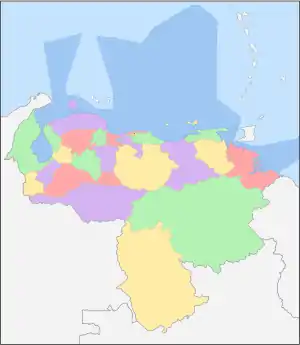
Venezuela is divided into 23 states (estados), a capital district (distrito capital) corresponding to the city of Caracas, and the Federal Dependencies (Dependencias Federales, a special territory). Venezuela is further subdivided into 335 municipalities (municipios); these are subdivided into over one thousand parishes (parroquias). The states are grouped into nine administrative regions (regiones administrativas), which were established in 1969 by presidential decree.
The country can be further divided into ten geographical areas, some corresponding to climatic and biogeographical regions. In the north are the Venezuelan Andes and the Coro region, a mountainous tract in the northwest, holds several sierras and valleys. East of it are lowlands abutting Lake Maracaibo and the Gulf of Venezuela.
The Central Range runs parallel to the coast and includes the hills surrounding Caracas; the Eastern Range, separated from the Central Range by the Gulf of Cariaco, covers all of Sucre and northern Monagas. The Insular Region includes all of Venezuela's island possessions: Nueva Esparta and the various Federal Dependencies. The Orinoco Delta, which forms a triangle covering Delta Amacuro, projects northeast into the Atlantic Ocean.
Additionally, the country maintains a historical claim on the territory it calls Guyana Esequiba, which is equivalent to about 160,000 square kilometers and corresponds to all the territory administered by Guyana west of the Esequibo River. In 1966 the British and Venezuelan governments signed the Geneva Agreement to resolve the conflict peacefully. In addition to this agreement, the Port of Spain Protocol of 1970 set a deadline to try to resolve the issue, without success to date.
| State | Capital | State | Capital |
|---|---|---|---|
| Puerto Ayacucho | Mérida | ||
| Barcelona | Los Teques | ||
| San Fernando de Apure | Maturín | ||
| Maracay | La Asunción | ||
| Barinas | Guanare | ||
| Ciudad Bolívar | Cumaná | ||
| Valencia | San Cristóbal | ||
| San Carlos | Trujillo | ||
| Tucupita | San Felipe | ||
| Caracas | Maracaibo | ||
| Coro | La Guaira | ||
| San Juan de los Morros | El Gran Roque | ||
| Barquisimeto | |||
| 1 The Federal Dependencies are not states. They are just special divisions of the territory. | |||
Largest cities
Economy
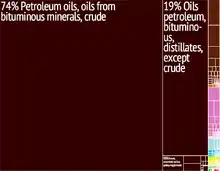
Venezuela has a market-based mixed economy dominated by the petroleum sector,[251][252] which accounts for roughly a third of GDP, around 80% of exports, and more than half of government revenues. Per capita GDP for 2016 was estimated to be US$15,100, ranking 109th in the world.[66] Venezuela has the least expensive petrol in the world because the consumer price of petrol is heavily subsidized. The private sector controls two-thirds of Venezuela's economy.[253]
The Central Bank of Venezuela is responsible for developing monetary policy for the Venezuelan bolívar which is used as currency. The president of the Central Bank of Venezuela serves as the country's representative in the International Monetary Fund. The U.S.-based conservative think tank The Heritage Foundation, cited in The Wall Street Journal, claims Venezuela has the weakest property rights in the world, scoring only 5.0 on a scale of 100; expropriation without compensation is not uncommon.
As of 2011, more than 60% of Venezuela's international reserves was in gold, eight times more than the average for the region. Most of Venezuela's gold held abroad was located in London. On 25 November 2011, the first of US$11 billion of repatriated gold bullion arrived in Caracas; Chávez called the repatriation of gold a "sovereign" step that will help protect the country's foreign reserves from the turmoil in the U.S. and Europe.[254] However government policies quickly spent down this returned gold and in 2013 the government was forced to add the dollar reserves of state owned companies to those of the national bank to reassure the international bond market.[255]
Manufacturing contributed 17% of GDP in 2006. Venezuela manufactures and exports heavy industry products such as steel, aluminium and cement, with production concentrated around Ciudad Guayana, near the Guri Dam, one of the largest in the world and the provider of about three-quarters of Venezuela's electricity. Other notable manufacturing includes electronics and automobiles, as well as beverages, and foodstuffs. Agriculture in Venezuela accounts for approximately 3% of GDP, 10% of the labor force, and at least a quarter of Venezuela's land area. The country is not self-sufficient in most areas of agriculture. In 2012, total food consumption was over 26 million metric tonnes, a 94.8% increase from 2003.[258]
Since the discovery of oil in the early 20th century, Venezuela has been one of the world's leading exporters of oil, and it is a founding member of OPEC. Previously an underdeveloped exporter of agricultural commodities such as coffee and cocoa, oil quickly came to dominate exports and government revenues. The 1980s oil glut led to an external debt crisis and a long-running economic crisis, which saw inflation peak at 100% in 1996 and poverty rates rise to 66% in 1995[259] as (by 1998) per capita GDP fell to the same level as 1963, down a third from its 1978 peak.[260] The 1990s also saw Venezuela experience a major banking crisis in 1994.
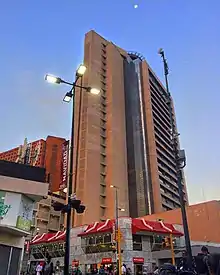
The recovery of oil prices after 2001 boosted the Venezuelan economy and facilitated social spending. With social programs such as the Bolivarian Missions, Venezuela initially made progress in social development in the 2000s, particularly in areas such as health, education, and poverty. Many of the social policies pursued by Chávez and his administration were jump-started by the Millennium Development Goals, eight goals that Venezuela and 188 other nations agreed to in September 2000.[261] The sustainability of the Bolivarian Missions has been questioned due to the Bolivarian state's overspending on public works and because the Chávez government did not save funds for future economic hardships like other OPEC nations; with economic issues and poverty rising as a result of their policies in the 2010s.[25][262][263] In 2003 the government of Hugo Chávez implemented currency controls after capital flight led to a devaluation of the currency. This led to the development of a parallel market of dollars in the subsequent years. The fallout of the 2008 global financial crisis saw a renewed economic downturn. Despite controversial data shared by the Venezuelan government showing that the country had halved malnutrition following one of the UN's Millennium Development Goals,[115][264] shortages of staple goods began to occur in Venezuela and malnutrition began to increase.[115]
In early 2013, Venezuela devalued its currency due to growing shortages in the country.[265][266][267] The shortages included, and still include, necessities such as toilet paper, milk, and flour.[268] Fears rose so high due to the toilet paper shortage that the government occupied a toilet paper factory, and continued further plans to nationalize other industrial aspects like food distribution.[269][270] Venezuela's bond ratings have also decreased multiple times in 2013 due to decisions by the president Nicolás Maduro. One of his decisions was to force stores and their warehouses to sell all of their products, which led to even more shortages in the future.[271] In 2016, consumer prices in Venezuela increased 800% and the economy declined by 18.6%, entering an economic depression.[272][273] Venezuela's outlook was deemed negative by most bond-rating services in 2017.[274][275] For 2018 an inflation rate of 1,000,000 percent was projected, putting Venezuela in a similar situation to that in Germany in 1923 or Zimbabwe in the late 2000s.[276]
Tourism
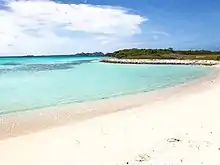
Tourism has been developed considerably in recent decades, particularly because of its favorable geographical position, the variety of landscapes, the richness of plant and wildlife, the artistic expressions and the privileged tropical climate of the country, which affords each region (especially the beaches) throughout the year.
Margarita Island is one of the top tourist destinations for enjoyment and relaxation. It is an island with a modern infrastructure, bordered by beautiful beaches suitable for extreme sports, and features castles, fortresses and churches of great cultural value.
Los Roques Archipelago is made up of a set of islands and keys that constitute one of the main tourist attractions in the country. With exotic crystalline beaches, Morrocoy is a national park, formed by small keys very close to the mainland, which have grown rapidly as one of the greatest tourist attractions in the Venezuelan Caribbean.[277]
Canaima National Park[278] extends over 30,000 km2 to the border with Guyana and Brazil, due to its size it is considered the sixth largest national park in the world. About 65% of the park is occupied by rock plateaus called tepuis. These constitute a unique biological environment, also presenting great geological interest. Its steep cliffs and waterfalls (including Angel Falls, which is the highest waterfall in the world, at 1,002 m) form spectacular landscapes.
The state of Mérida,[279] for the beauty of its Andean landscapes and its pleasant climate, is one of the main tourist centers of Venezuela. It has an extensive network of hotels not only in its capital city, but also throughout the state. Starting from the same city of Mérida, is the longest and highest cable car in the world, which reaches the Pico Espejo of 4,765 m. It is also necessary to recommend to travel through magnificent roads, the southern moors, where you can find good hotels and restaurants.
Shortages
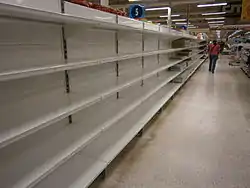
Shortages in Venezuela have been prevalent following the enactment of price controls and other policies during the economic policy of the Hugo Chávez government.[280][281] Under the economic policy of the Nicolás Maduro government, greater shortages occurred due to the Venezuelan government's policy of withholding United States dollars from importers with price controls.[282]
Shortages occur in regulated products, such as milk, various types of meat, coffee, rice, oil, flour, butter, and other goods including basic necessities like toilet paper, personal hygiene products, and even medicine.[280][283][284] As a result of the shortages, Venezuelans must search for food, wait in lines for hours and sometimes settle without having certain products.[285][286] Maduro's government has blamed the shortages on "bourgeois criminals" hoarding goods.[287]
A drought, combined with a lack of planning and maintenance, has caused a hydroelectricity shortage. To deal with lack of power supply, in April 2016 the Maduro government announced rolling blackouts[288] and reduced the government workweek to only Monday and Tuesday.[289] A multi-university study found that, in 2016 alone, about 75% of Venezuelans lost weight due to hunger, with the average losing about 8.6 kg (19 lbs) due to the lack of food.[290]
By late-2016 and into 2017, Venezuelans had to search for food on a daily basis, occasionally resorting to eating wild fruit or garbage, wait in lines for hours and sometimes settle without having certain products.[291][286][292][293][294] By early 2017, priests began telling Venezuelans to label their garbage so needy individuals could feed on their refuse.[295] In March 2017, Venezuela, with the largest oil reserves in the world, began having shortages of gasoline in some regions with reports that fuel imports had begun.[296]
Petroleum and other resources
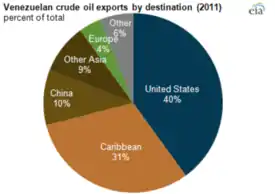
Venezuela has the largest oil reserves, and the eighth largest natural gas reserves in the world.[298] Compared to the preceding year another 40.4% in crude oil reserves were proven in 2010, allowing Venezuela to surpass Saudi Arabia as the country with the largest reserves of this type.[299] The country's main petroleum deposits are located around and beneath Lake Maracaibo, the Gulf of Venezuela (both in Zulia), and in the Orinoco River basin (eastern Venezuela), where the country's largest reserve is located. Besides the largest conventional oil reserves and the second-largest natural gas reserves in the Western Hemisphere,[300] Venezuela has non-conventional oil deposits (extra-heavy crude oil, bitumen and tar sands) approximately equal to the world's reserves of conventional oil.[301] The electricity sector in Venezuela is one of the few to rely primarily on hydropower, and includes the Guri Dam, one of the largest in the world.
In the first half of the 20th century, U.S. oil companies were heavily involved in Venezuela, initially interested only in purchasing concessions.[302] In 1943 a new government introduced a 50/50 split in profits between the government and the oil industry. In 1960, with a newly installed democratic government, Hydrocarbons Minister Juan Pablo Pérez Alfonso led the creation of OPEC, the consortium of oil-producing countries aiming to support the price of oil.[303]
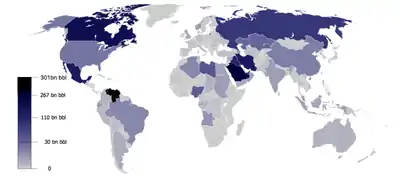
In 1973, Venezuela voted to nationalize its oil industry outright, effective 1 January 1976, with Petróleos de Venezuela (PDVSA) taking over and presiding over a number of holding companies; in subsequent years, Venezuela built a vast refining and marketing system in the U.S. and Europe.[304] In the 1990s PDVSA became more independent from the government and presided over an apertura (opening) in which it invited in foreign investment. Under Hugo Chávez a 2001 law placed limits on foreign investment.
The state oil company PDVSA played a key role in the December 2002 – February 2003 national strike which sought President Chávez' resignation. Managers and skilled highly paid technicians of PDVSA shut down the plants and left their posts, and by some reports sabotaged equipment, and petroleum production and refining by PDVSA almost ceased. Activities eventually were slowly restarted by returning and substitute oil workers. As a result of the strike, around 40% of the company's workforce (around 18,000 workers) were dismissed for "dereliction of duty" during the strike.[305][306]
Transport
.jpg.webp)
Venezuela is connected to the world primarily via air (Venezuela's airports include the Simón Bolívar International Airport in Maiquetía, near Caracas and La Chinita International Airport near Maracaibo) and sea (with major sea ports at La Guaira, Maracaibo and Puerto Cabello). In the south and east the Amazon rainforest region has limited cross-border transport; in the west, there is a mountainous border of over 2,213 kilometres (1,375 mi) shared with Colombia. The Orinoco River is navigable by oceangoing vessels up to 400 kilometres (250 mi) inland, and connects the major industrial city of Ciudad Guayana to the Atlantic Ocean.
Venezuela has a limited national railway system, which has no active rail connections to other countries. The government of Hugo Chávez tried to invest in expanding it, but Venezuela's rail project is on hold due to Venezuela not being able to pay the $7.5 billion and owing China Railway nearly $500 million.[307] Several major cities have metro systems; the Caracas Metro has been operating since 1983. The Maracaibo Metro and Valencia Metro were opened more recently. Venezuela has a road network of nearly 100,000 kilometres (62,000 mi) in length, placing the country around 45th in the world;[308] around a third of roads are paved.
Demographics
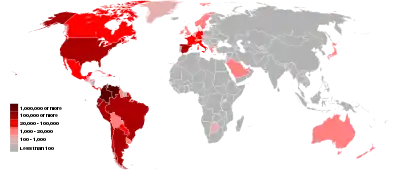
Venezuela is among the most urbanized countries in Latin America;[14][15] the vast majority of Venezuelans live in the cities of the north, especially in the capital Caracas, which is also the largest city. About 93% of the population lives in urban areas in northern Venezuela; 73% live less than 100 kilometres (62 mi) from the coastline.[309] Though almost half of Venezuela's land area lies south of the Orinoco, only 5% of Venezuelans live there. The largest and most important city south of the Orinoco is Ciudad Guayana, which is the sixth most populous conurbation.[310] Other major cities include Barquisimeto, Valencia, Maracay, Maracaibo, Barcelona-Puerto La Cruz, Mérida and San Cristóbal.
According to a 2014 study by sociologists of the Central University of Venezuela, over 1.5 million Venezuelans, or about 4% to 6% of the country's population, have left Venezuela since 1999 following the Bolivarian Revolution.[311][312]
Ethnic groups
The people of Venezuela come from a variety of ancestries. It is estimated that the majority of the population is of mestizo, or mixed, ethnic ancestry. Nevertheless, in the 2011 census, which Venezuelans were asked to identify themselves according to their customs and ancestry, the term mestizo was excluded from the answers. The majority claimed to be mestizo or white—51.6% and 43.6%, respectively.[1] Practically half of the population claimed to be moreno, a term used throughout Ibero-America that in this case means "dark-skinned" or "brown-skinned", as opposed to having a lighter skin (this term connotes skin color or tone, rather than facial features or descent).
Ethnic minorities in Venezuela consist of groups that descend mainly from African or indigenous peoples; 2.8% identified themselves as "black" and 0.7% as afrodescendiente (Afro-descendant), 2.6% claimed to belong to indigenous peoples, and 1.2% answered "other races".[1]
Among indigenous people, 58% were Wayúu, 7% Warao, 5% Kariña, 4% Pemón, 3% Piaroa, 3% Jivi, 3% Añu, 3% Cumanágoto, 2% Yukpa, 2% Chaima and 1% Yanomami; the remaining 9% consisted of other indigenous nations.[313]
According to an autosomal DNA genetic study conducted in 2008 by the University of Brasília (UNB), the composition of Venezuela's population is 60.60% of European contribution, 23% of indigenous contribution, and 16.30% of African contribution.[314]
_population_proportion_map.png.webp)
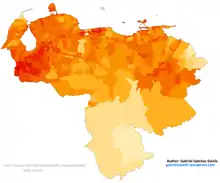

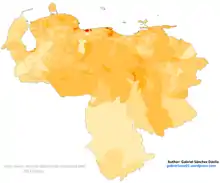
During the colonial period and until after the Second World War, many of the European immigrants to Venezuela came from the Canary Islands,[315] which had a significant cultural impact on the cuisine and customs of Venezuela.[316][317][318] These influences on Venezuela have led to the nation being called the 8th island of the Canaries.[319][320] With the start of oil exploitation in the early 20th century, companies from the United States began establishing operations in Venezuela, bringing with them U.S. citizens. Later, during and after the war, new waves of immigrants from other parts of Europe, the Middle East, and China began; many were encouraged by government-established immigration programs and lenient immigration policies.[321] During the 20th century, Venezuela, along with the rest of Latin America, received millions of immigrants from Europe.[322][323] This was especially true post-World War II, as a consequence of war-ridden Europe.[322][323][324] During the 1970s, while experiencing an oil-export boom, Venezuela received millions of immigrants from Ecuador, Colombia, and the Dominican Republic.[324] Due to the belief that this immigration influx depressed wages, some Venezuelans opposed European immigration.[324] The Venezuelan government, however, were actively recruiting immigrants from Eastern Europe to fill a need for engineers.[322] Millions of Colombians, as well as Middle Eastern and Haitian populations would continue immigrating to Venezuela into the early 21st century.[321]
According to the World Refugee Survey 2008, published by the U.S. Committee for Refugees and Immigrants, Venezuela hosted a population of refugee and asylum seekers from Colombia numbering 252,200 in 2007, and 10,600 new asylum seekers entered Venezuela in 2007.[325] Between 500,000 and one million illegal immigrants are estimated to be living in the country.[326]
The total indigenous population of the country is estimated at about 500 thousand people (2.8% of the total), distributed among 40 indigenous peoples.[327] There are three uncontacted tribes living in Venezuela. The Constitution recognizes the multi-ethnic, pluri-cultural, and multilingual character of the country and includes a chapter devoted to indigenous peoples' rights, which opened up spaces for their political inclusion at national and local level in 1999. Most indigenous peoples are concentrated in eight states along Venezuela's borders with Brazil, Guyana, and Colombia, and the majority groups are the Wayuu (west), the Warao (east), the Yanomami (south), and the Pemon (southeast).
Languages
Although most residents are monolingual Spanish speakers, many languages are spoken in Venezuela. In addition to Spanish, the Constitution recognizes more than thirty indigenous languages, including Wayuu, Warao, Pemón, and many others for the official use of the indigenous peoples, mostly with few speakers – less than 1% of the total population. Wayuu is the most spoken indigenous language with 170,000 speakers.[328]
Immigrants, in addition to Spanish, speak their own languages. Chinese (400,000), Portuguese (254,000),[328] and Italian (200,000)[329] are the most spoken languages in Venezuela after the official language of Spanish. Arabic is spoken by Lebanese and Syrian colonies on Isla de Margarita, Maracaibo, Punto Fijo, Puerto la Cruz, El Tigre, Maracay, and Caracas. Portuguese is spoken not only by the Portuguese community in Santa Elena de Uairén but also by much of the population due to its proximity to Brazil.[330] The German community speaks their native language, while the people of Colonia Tovar speak mostly an Alemannic dialect of German called alemán coloniero.
English is the most widely used foreign language in demand and is spoken by many professionals, academics, and members of the upper and middle classes as a result of the oil exploration done by foreign companies, in addition to its acceptance as a lingua franca. Culturally, English is common in southern towns like El Callao, and the native English-speaking influence is evident in folk and calypso songs from the region. English was brought to Venezuela by Trinidadian and other British West Indies immigrants.[331] A variety of Antillean Creole is spoken by a small community in El Callao and Paria.[332] Italian language teaching is guaranteed by the presence of a consistent number of private Venezuelan schools and institutions, where Italian language courses and Italian literature are active. Other languages spoken by large communities in the country are Basque and Galician, among others.
Religion
According to a 2011 poll (GIS XXI), 88% of the population is Christian, primarily Roman Catholic (71%), and the remaining 17% Protestant, primarily Evangelicals (in Latin America Protestants are usually called "evangelicos"). 8% of Venezuelans are irreligious (atheist 2% and agnostic and 6% indifferent). Almost 3% of the population follow another religion (1% of these people practice Santería).[2]
There are small but influential Muslim, Druze,[333][334] Buddhist, and Jewish communities. The Muslim community of more than 100,000 is concentrated among persons of Lebanese and Syrian descent living in Nueva Esparta State, Punto Fijo and the Caracas area. The Druze community are estimated around 60,000 and concentrated among persons of Lebanese and Syrian descent (a former vice president is Druze, showing the small group's influence).[335][333] Buddhism in Venezuela is practiced by over 52,000 people. The Buddhist community is made up mainly of Chinese, Japanese, and Korean people. There are Buddhist centers in Caracas, Maracay, Mérida, Puerto Ordáz, San Felipe, and Valencia.
The Jewish community has shrunk in recent years due to rising antisemitism in Venezuela,[336][337][338][339][340] with the population declining from 22,000 in 1999[341] to less than 7,000 in 2015.[342]
Health
Venezuela has a national universal health care system. The current government has created a program to expand access to health care known as Misión Barrio Adentro,[344][345] although its efficiency and work conditions have been criticized.[346][347][348] It has been reported that many Misión Barrio Adentro clinics have been closed, and (as of December 2014) it is estimated that 80% of Barrio Adentro establishments in Venezuela are abandoned.[349][350]
Infant mortality in Venezuela was 19 deaths per 1,000 births for 2014 which was lower than the South American average (To compare: The U.S. figure was 6 deaths per 1,000 births in 2013 and the Canadian figure was 4.5 deaths per 1,000 live births).[351] Child malnutrition (defined as stunting or wasting in children under the age of five) was 17%. Delta Amacuro and Amazonas had the nation's highest rates.[352] According to the United Nations, 32% of Venezuelans lacked adequate sanitation, primarily those living in rural areas.[353] Diseases ranging from diphtheria, plague, malaria,[234] typhoid fever, yellow fever, cholera, hepatitis A, hepatitis B, and hepatitis D were present in the country.[354] Obesity was prevalent in approximately 30% of the adult population in Venezuela.[351]
Venezuela had a total of 150 sewage treatment plants; however, 13% of the population lacked access to drinking water, but this number had been dropping.[355]
During the economic crisis observed under President Maduro's presidency, medical professionals were forced to perform outdated treatments on patients.[356]
Education
The literacy rate of the adult population was already at 91.1% by 1998.[357] In 2008, 95.2% of the adult population was literate.[358] The net primary school enrollment rate was at 91% and the net secondary school enrollment rate was at 63% in 2005.[358] Venezuela has a number of universities, of which the most prestigious are the Central University of Venezuela (UCV) founded in Caracas in 1721, the University of Zulia (LUZ) founded in 1891, the University of the Andes (ULA) founded in Mérida State in 1810, the Simón Bolívar University (USB) founded in Miranda State in 1967, and the University of the East (UDO) founded in Sucre State in 1958.
Currently, many Venezuelan graduates seek a future abroad because of the country's troubled economy and heavy crime rate. In a study titled "Venezolana Community Abroad: A New Method of Exile" by Thomas Páez, Mercedes Vivas, and Juan Rafael Pulido of the Central University of Venezuela, over 1.35 million Venezuelan college graduates have left the country since the beginning of the Bolivarian Revolution.[311][312] It is believed that nearly 12% of Venezuelans live abroad, with Ireland becoming a popular destination for students.[362] According to Claudio Bifano, president of the Venezuelan Academy of Physical, Mathematical, and Natural Sciences, more than half of all medical graduates had left Venezuela in 2013.[363]
By 2018, over half of all Venezuelan children had dropped out of school, with 58% of students quitting nationwide while areas near bordering countries saw more than 80% of their students leave.[364][365] Nationwide, about 93% of schools do not meet the minimum requirements to operate and 77% do not have utilities such as food, water or electricity.[365]
Culture
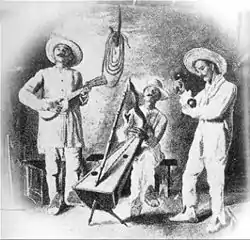
The culture of Venezuela is a melting pot made up of three main groups: The Indigenous Venezuelans, the Africans, and the Spanish. The first two cultures were in turn differentiated according to their tribes. Acculturation and assimilation, typical of a cultural syncretism, led to the Venezuelan culture of the present day, which is similar in many ways to the culture of the rest of Latin America, but still has its own unique characteristics.
The indigenous and African influence is limited to a few words, food names, and place names. However, the Africans also brought in many musical influences, especially introduction of the drum. The Spanish influence predominantes due to the colonization process and the socioeconomic structure it created, and in particular came from the regions of Andalusia and Extremadura (the places of origin of most of the settlers in the Caribbean during the colonial era). Spanish influences can be seen in the country's architecture, music, religion, and language.
Spanish influences can also be seen in the bullfights that take place in Venezuela, and in certain gastronomical features. Venezuela was also enriched by immigration streams of Indian and European origin in the 19th century, especially from France. Most recently, immigration from the United States, Spain, Italy, and Portugal has further enriched the already complex cultural mosaic (especially in large oil-producing cities).
Architecture
Carlos Raúl Villanueva was the most important Venezuelan architect of the modern era; he designed the Central University of Venezuela, (a World Heritage Site) and its Aula Magna. Other notable architectural works include the Capitolio, the Baralt Theatre, the Teresa Carreño Cultural Complex, and the General Rafael Urdaneta Bridge.
Art

Venezuelan art was initially dominated by religious motifs. However, in the late 19th century, artists began emphasizing historical and heroic representations of the country's struggle for independence.[366][367] This move was led by Martín Tovar y Tovar.[367][368] Modernism took over in the 20th century.[368] Notable Venezuelan artists include Arturo Michelena, Cristóbal Rojas, Armando Reverón, Manuel Cabré; the kinetic artists Jesús Soto, Gego and Carlos Cruz-Diez;[368] and contemporary artists such as Marisol and Yucef Merhi.[369][370]
Literature
Venezuelan literature originated soon after the Spanish conquest of the mostly pre-literate indigenous societies.[371] It was originally dominated by Spanish influences. Following the rise of political literature during the Venezuelan War of Independence, Venezuelan Romanticism, notably expounded by Juan Vicente González, emerged as the first important genre in the region. Although mainly focused on narrative writing, Venezuelan literature was advanced by poets such as Andrés Eloy Blanco and Fermín Toro.
Major writers and novelists include Rómulo Gallegos, Teresa de la Parra, Arturo Uslar Pietri, Adriano González León, Miguel Otero Silva, and Mariano Picón Salas. The great poet and humanist Andrés Bello was also an educator and intellectual (He was also a childhood tutor and mentor of Simón Bolívar). Others, such as Laureano Vallenilla Lanz and José Gil Fortoul, contributed to Venezuelan Positivism.
Music
.jpg.webp)
The indigenous musical styles of Venezuela are exemplified by groups like Un Sólo Pueblo and Serenata Guayanesa. The national musical instrument is the cuatro. Traditional musical styles and songs mainly emerged in and around the llanos region, including, "Alma llanera" (by Pedro Elías Gutiérrez and Rafael Bolívar Coronado), "Florentino y el diablo" (by Alberto Arvelo Torrealba), "Concierto en la llanura" by Juan Vicente Torrealba, and "Caballo viejo" (by Simón Díaz).
The Zulian gaita is also a very popular genre, generally performed during Christmas. The national dance is the joropo.[372] Venezuela has always been a melting pot of cultures and this can be seen in the richness and variety of its musical styles and dances: calipso, bambuco, fulía, cantos de pilado de maíz, cantos de lavanderas, sebucán, and maremare.[373] Teresa Carreño was a world-famous 19th century piano virtuoso. Recently, great classical music performances have come out of Venezuela. The Simón Bolívar Youth Orchestra, under the leadership of its principal conductor Gustavo Dudamel and José Antonio Abreu, has hosted a number of excellent concerts in many European concert halls, most notably at the 2007 London Proms, and has received several honors. The orchestra is the pinnacle of El Sistema, a publicly financed, voluntary music education program now being emulated in other countries.
In the early 21st century, a movement known as "Movida Acústica Urbana" featured musicians trying to save some national traditions, creating their own original songs but using traditional instruments.[374][375] Some groups following this movement are Tambor Urbano,[376] Los Sinverguenzas, C4Trío, and Orozco Jam.[377]
Afro-Venezuelan musical traditions are most intimately related to the festivals of the "black folk saints" San Juan and St. Benedict the Moor. Specific songs are related to the different stages of their festivals and processions, when the saints start their yearly "paseo" – stroll – through the community to dance with their people.
Sport
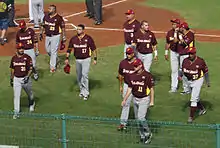
The origins of baseball in Venezuela are unclear, although it is known that the sport was being played in the country by the late 19th century.[378] In the early 20th century, North American immigrants who came to Venezuela to work in the nation's oil industry helped to popularize the sport in Venezuela.[379] During the 1930s, baseball's popularity continued to rise in the country, leading to the foundation of the Venezuelan Professional Baseball League (LVBP) in 1945, and the sport would soon become the nation's most popular.[380][381]
The immense popularity of baseball in the country makes Venezuela a rarity among its South American neighbors—association football is the dominant sport in the continent.[379][381][382] However, football, as well as basketball, are among the more popular sports played in Venezuela.[383] Venezuela hosted the 2012 Basketball World Olympic Qualifying Tournament and the 2013 FIBA Basketball Americas Championship, which took place in the Poliedro de Caracas.
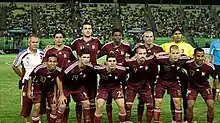
Although not as popular in Venezuela as the rest of South America, football, spearheaded by the Venezuela national football team is gaining popularity as well. The sport is also noted for having an increased focus during the World Cup.[383] According to the CONMEBOL alphabetical rotation policy established in 2011, Venezuela is scheduled to host the Copa América every 40 years.[384]
Venezuela is also home to former Formula 1 driver, Pastor Maldonado.[385] At the 2012 Spanish Grand Prix, he claimed his first pole and victory, and became the first and only Venezuelan to have done so in Formula 1 history.[385] Maldonado has increased the reception of Formula 1 in Venezuela, helping to popularize the sport in the country.[386]
In the 2012 Summer Olympics, Venezuelan Rubén Limardo won a gold medal in fencing.[387]
Cuisine
Notes
- Recognized as president by the National Constituent Assembly, the Supreme Tribunal of Justice, the National Electoral Council, National Bolivarian Armed Forces and the United Nations.[3]
- Recognized as president by the Supreme Tribunal in Exile.
References
- "Resultado Básico del XIV Censo Nacional de Población y Vivienda 2011 (Mayo 2014)" (PDF). Ine.gov.ve. p. 29. Retrieved 8 September 2014.
- Aguire, Jesus Maria (June 2012). "Informe Sociográfico sobre la religión en Venezuela" (PDF) (in Spanish). El Centro Gumilla. Archived from the original (PDF) on 24 September 2015. Retrieved 5 April 2015.
- "Report of the Credentials Committee". United Nations General Assembly. Retrieved 29 January 2020.
- "Venezuela (Bolivarian Republic of)'s Constitution of 1999 with Amendments through 2009" (PDF). constituteproject.org. Retrieved 21 October 2020.
- ""World Population prospects – Population division"". population.un.org. United Nations Department of Economic and Social Affairs, Population Division. Retrieved 9 November 2019.
- ""Overall total population" – World Population Prospects: The 2019 Revision" (xslx). population.un.org (custom data acquired via website). United Nations Department of Economic and Social Affairs, Population Division. Retrieved 9 November 2019.
- "Report for Selected Countries and Subjects". www.imf.org. Retrieved 25 May 2019.
- "World Economic Outlook Database, October 2020". IMF.org. International Monetary Fund. Retrieved 20 April 2020.
- "World Economic Outlook Database, October 2020". IMF.org. International Monetary Fund. Retrieved 20 October 2019.
- "Income Gini coefficient". United Nations Development Programme. United Nations. Retrieved 21 September 2015.
- Human Development Report 2020 The Next Frontier: Human Development and the Anthropocene (PDF). United Nations Development Programme. 15 December 2020. pp. 343–346. ISBN 978-92-1-126442-5. Retrieved 16 December 2020.
- "Constitución de la República Bolivariana de Venezuela" (PDF). Ministry of Education. 15 December 1999. Archived from the original (PDF) on 1 October 2013. Retrieved 19 March 2013.
- "Geneva Agreement, 17 February 1966" (PDF). United Nations.
- "South America". Encarta. Archived from the original on 21 April 2007. Retrieved 13 March 2007.
- "Annex tables" (PDF). World Urbanization Prospects: The 1999 Revision. United Nations. Retrieved 13 March 2007.
- "The Legacy of Hugo Chavez and a Failing Venezuela". Wharton Public Policy Initiative. Retrieved 16 May 2020.
- Smilde, David (14 September 2017). "Crime and Revolution in Venezuela". NACLA Report on the Americas. 49 (3): 303–308. doi:10.1080/10714839.2017.1373956. ISSN 1071-4839. S2CID 158528940.
Finally, it is important to realize that the reductions in poverty and inequality during the Chávez years were real, but somewhat superficial. While indicators of income and consumption showed clear progress, the harder-to-change characteristics of structural poverty and inequality, such as the quality of housing, neighborhoods, education, and employment, remained largely unchanged.
- Heritage 2002, pp. 618–621.
- Kevin Voigt (6 March 2013). Chavez leaves Venezuelan economy more equal, less stable. CNN. Retrieved 5 April 2014.
- Dan Beeton and Joe Sammut (6 December 2013). Venezuela Leads Region in Poverty Reduction in 2012, ECLAC Says. Center for Economic and Policy Research. Retrieved 5 April 2014.
- Venezuela Overview. The World Bank. Last updated 17 November 2014:
- "Economic growth and the redistribution of resources associated with these missions have led to an important decline in moderate poverty, from 50% in 1998 to about 30% in 2012. Likewise, inequality has decreased, reducing the Gini Index from 0.49 in 1998 to 0.39 in 2012, which is among the lowest in the region."
- [18][19][20][21]
- 남민우, 기 (2 May 2018). 화폐경제 무너졌는데…최저임금 인상에 목매는 베네수엘라. 朝鮮日報 (in Korean). Retrieved 22 May 2018.
Venezuela's fall is considered to be mainly caused by the populist policy
- "Fuel subsidies have contributed to Venezuela's economic crisis". www.chinadialogue.net.
- Scharfenberg, Ewald (1 February 2015). "Volver a ser pobre en Venezuela". El Pais. Retrieved 3 February 2015.
- Rosati, Andrew (9 October 2018). "Venezuela's 2018 Inflation to Hit 1.37 Million Percent, IMF Says". Bloomberg. Retrieved 9 October 2018.
- "IMF sees Venezuela inflation at 10 million percent in 2019". 9 October 2018 – via in.reuters.com.
- • Gillespie, Patrick (12 December 2016). "Venezuela shuts border with Colombia as cash crisis escalates". CNNMoney. Retrieved 17 January 2017. • Gillespie, Patrick (12 April 2016). "Venezuela: the land of 500% inflation". CNNMoney. Retrieved 17 January 2017.
• Rosati, Andrew (11 January 2017). "Venezuela's Economy Was the Worst Performing of 2016, IMF Estimates". Bloomberg. Retrieved 17 January 2017. - "Chamber of Commerce: 80% of Venezuelans are in poverty". El Universal. 1 April 2016. Archived from the original on 4 April 2016. Retrieved 4 April 2016.
- Herrero, Ana Vanessa; Malkin, Elisabeth (16 January 2017). "Venezuela Issues New Bank Notes Because of Hyperinflation". The New York Times. Retrieved 17 January 2017.
- "Number of refugees and migrants from Venezuela reaches 3 million". UNHCR. 8 November 2018. Retrieved 6 February 2019.
- Gillespie, Patrick (14 November 2017). "Venezuela just defaulted, moving deeper into crisis". CNNMoney. Retrieved 15 November 2017.
- "Venezuela in 'selective default'". BBC News. 14 November 2017. Retrieved 15 November 2017.
- Massabié 2008, p. 153.
- Thomas 2005, p. 189.
- "Cuadernos Hispanoamericanos" (in Spanish). Instituto de Cultura Hispánica (Agencia Española de Cooperación Internacional). 1958: 386. Cite journal requires
|journal=(help) - Kipfer 2000, p. 91.
- Kipfer 2000, p. 172.
- Wunder 2003, p. 130.
- Mahoney 89
- "Venezuela". Archived 4 September 2011 at the Wayback Machine Friends of the Pre-Columbian Art Museum. (retrieved 9 July 2011)
- Miguel Tinker Salas (2 August 2004). "Culture, Power, and Oil: The Experience of Venezuelan Oil Camps and the Construction of Citizenship". In Gilbert G. Gonzalez; Raul A. Fernandez; Vivian Price; David Smith; Linda Trinh Võ (eds.). Labor Versus Empire: Race, Gender, Migration. Routledge. p. 142. ISBN 978-1-135-93528-3.
- Dickey 1892, p. 103.
- Zamora 1993, pp. Voyage to Paradise.
- "Alcaldía del Hatillo: Historia" (in Spanish). Universidad Nueva Esparta. Archived from the original on 28 April 2006. Retrieved 10 March 2007.
- Gott 2005, p. 203.
- Ewell 1984, p. 4.
- Minster, Christopher. "April 19, 1810: Venezuela's Declaration of Independence". About. Retrieved 30 June 2015.
- Chasteen 2001, p. 103.
- Left, Sarah (16 April 2002). "Simon Bolivar". The Guardian. Retrieved 30 June 2015.
- Gregory 1992, pp. 89–90.
- "Venezuela". CIA World Factbook. Retrieved 3 February 2021.
- "History of Venezuela". History World. Retrieved 30 June 2015.
- McFarlane, Anthony (2013). War and Independence In Spanish America. Routledge. p. 293. ISBN 978-1136757723.
- "Venezuela – The Century of Caudillismo". Library of Congress Country Studies.
- "200 años como símbolo de soberanía" (in Spanish). Consulado General de Venezuela en Canarias. Archived from the original on 17 September 2010. Retrieved 30 November 2010.
- Zakaria 1999, pp. 145–146.
- Humphreys, R. A. (1966). "Anglo-American Rivalries and the Venezuela Crisis of 1895. Presidential Address to the Royal Historical Society". Transactions of the Royal Historical Society. 17: 131–164. doi:10.2307/3678723. JSTOR 3678723.
- Stauffer, Karl W.; Croft, Gregory D. (1995). "A modern look at the petroleum geology of the Maracaibo Basin, Venezuela". Oil & Gas Journal. 93 (23).
- Crow 1980, pp. 616–617.
- Stambouli, Andrés (2009). La política extraviada: Una historia de Medina a Chávez. Fundación para la Cultura Urbana. p. 97.
- Mujica, Viviana (2014). "El Centro Urbano El Recreo" (PDF). Historia y Patrimonio UCV.
- Coronil Ímber, Fernando (2013). Alfadil (ed.). El Estado Mágico (PDF).
- Ostos, Elizabeth (2016). "El mercado de hoteles se mueve a pesar de la recesión" (PDF). IESA Instituto de Estudios Superiores Administrativos.
- Stambouli, Andrés (2009). La política extraviada. Fundación para la Cultura Urbana. p. 98.
- "Venezuela". The World Factbook. CIA. 1 July 2010. Retrieved 23 July 2010.
- Palma, Pedro (2013). "La política cambiaria en Venezuela" (PDF). Boletín de la Academia Nacional de Ciencias Económicas. Archived from the original (PDF) on 5 April 2018.
- Cilento Sarli, Alfredo (2015). "El Ministerio de Obras Públicas en la Construcción de la Infraestructura para el Desarrollo (1874–1976)" (PDF). Boletín Academia Nacional de la Ingeniería y el Hábitat.
- Stambouli, Andrés (2009). La política extraviada: Una historia de Medina a Chávez. Fundación para la Cultura Urbana.
- Schuyler, George W. (2001). "Health and Neoliberalism: Venezuela and Cuba". The Policy Studies Organization: 10.
- Baptista, Asdrúbal (2006). "La Economía Venezolana Entre Siglos" (PDF). Boletín de la Academia Nacional de Ciencias Económicas.
- Conde, Edith Mabel Cuñarro (2004). "Venezuela 1984–1999: 15 años de historia (La Comisión Presidencial para la Reforma del Estado (COPRE) como mecanismo de innovación política)". Cuestiones Políticas (in Spanish). 20 (33). ISSN 0798-1406. Retrieved 8 April 2018.
- "Profile: Hugo Chavez". BBC News. 5 December 2002. Retrieved 5 June 2007.
- "Hugo Chávez and the Future of Venezuela".
- The coup installed chamber of commerce leader Pedro Carmona."Profile: Pedro Carmona". BBC. 27 May 2002. Retrieved 6 February 2009.
- Cannon 2004, p. 295.
- López Maya 2005, p. 16.
- "Minister: 2002–2003 strike cost PDVSA US$12.8bn – BNamericas". 27 July 2005.
- Jones, Bart (2008), Hugo! The Hugo Chávez Story From Mud Hut to Perpetual Revolution, London: The Bodley Head, p386
- "Venezuela devalues currency against US dollar". Aljazeera.com (9 February 2013). Retrieved on 20 April 2013.
- Cardenas, Jose R. (26 February 2013) "CARDENAS: Hugo Chavez's legacy of economic chaos". Washingtontimes.com. Retrieved on 20 April 2013.
- "The bill for years of mismanagement is coming due". Ft.com (12 February 2013). Retrieved on 20 April 2013.
- "Venezuela The homecoming". Economist.com (23 February 2013). Retrieved on 20 April 2013.
- Farzad, Roben. (15 February 2013) "Venezuela's Double-Edged Devaluation". Businessweek.com. Retrieved on 20 April 2013.
- Mander, Benedict. (10 February 2013) "Venezuelan devaluation sparks panic". Ft.com. Retrieved on 20 April 2013.
- Boyd, Sebastian (7 October 2014). "How Venezuela Got No Dollars From $65 Billion Bond Sales". www.bloomberg.com. Bloomberg L.P. Archived from the original on 9 October 2014. Retrieved 8 October 2014.
- Neuman, William (5 March 2013) "Chávez Dies, Leaving Sharp Divisions in Venezuela". New York Times.
- Venezuelan Politics and Human Rights. Venezuelablog.tumblr.com. Retrieved on 20 April 2013.
- Charlie Devereux & Raymond Colitt. 7 March 2013. "Venezuelans' Quality of Life Improved in UN Index Under Chavez". Bloomberg L.P. Archived from the original on 7 November 2014. Retrieved 7 March 2013.CS1 maint: unfit URL (link)
- Naranjo, Andrew Cawthorne and Mario. "FACTBOX – Chavez's chosen successor Nicolas Maduro".
- Watts, Virginia Lopez Jonathan (15 April 2013). "Nicolás Maduro narrowly wins Venezuelan presidential election" – via www.theguardian.com.
- "Venezuela audit confirms Nicolas Maduro electoral victory". BBC News. 12 June 2013. Retrieved 18 June 2013.
- Carroll, Rory; Lopez, Virginia (9 March 2013). "Venezuelan opposition challenges Nicolás Maduro's legitimacy". The Guardian. London.
- TSJ sobre Art.233: Nicolás Maduro es presidente encargado con todas las atribuciones Archived 1 January 2016 at the Wayback Machine. vtv.gob.ve (8 March 2013).
- Asamblea Nacional tomó Juramento a Nicolás Maduro como Presidente Encargado (+Video) Archived 30 October 2014 at the Wayback Machine. vtv.gob.ve (9 March 2013)
- "Venezuela's Maduro decried as 'dictator' after Congress annulled". Reuters. 31 March 2017. Retrieved 26 April 2017.
- José Miguel Vivanco (31 March 2017). "Venezuela's crumbling façade of democracy". Human Rights Watch.
This ruling is the end of Maduro administration's façade of democracy.
- Francisco Toro (21 October 2016). "It's official: Venezuela is a full-blown dictatorship". Washington Post.
- "Venezuela's Descent Into Dictatorship". The New York Times. 31 March 2017.
- Lopez, Linette (11 April 2014). "Why The United States Has Done Nothing About Venezuela". Business Insider. Retrieved 12 April 2014.
- Minaya, Ezequiel; Vyas, Kejal (23 February 2014). "Protesters in Venezuela Press Government". The Wall Street Journal. Retrieved 12 April 2014.
- "Venezuelans protest en masse in rival rallies". Borneo Post. 24 February 2014. Retrieved 12 April 2014.
- "Venezuela's Maduro says 2013 annual inflation was 56.2 pct". Reuters. 30 December 2013. Retrieved 19 January 2014.
- Kurmanaev, Anatoly (7 November 2013). "Venezuela Inflation Hits 16-Year High as Shortages Rise". Bloomberg. Retrieved 16 February 2014.
- Wallis, Daniel; Chinea, Eyanir (16 February 2014). "Venezuela's Lopez says ready for arrest at Tuesday march". reuters.com. Thomson Reuters. Retrieved 16 February 2014.
- "Venezuela HRF Declares Leopoldo Lopez a Prisoner of Conscience and Calls for his Immediate Release". Human Rights Foundation.
- Sabin, Lamiat (20 February 2015). "Mayor Antonio Ledezma arrested and dragged out of office 'like a dog' by police in Venezuela". The Independent. London. Retrieved 20 February 2015.
- "Sebin detuvo al alcalde Metropolitano Antonio Ledezma". El Universal. Retrieved 19 February 2015.
- "Sebin se lleva detenido al alcalde Antonio Ledezma". La Patilla. Retrieved 19 February 2015.
- "Detuvieron al alcalde Antonio Ledezma". El Nacional. Archived from the original on 20 February 2015.
- "Venezuela: Human rights groups reject condemnation of jailed Leopoldo Lopez as 'baseless'". International Business Times UK. Retrieved 17 November 2015.
- Rosati, Andrew; Soto, Noris (6 December 2015). "Venezuela Seen Handing Congress to Opposition in Sunday Vote". Bloomberg L.P. Retrieved 22 August 2016.
- Minaya, Ezequiel (9 February 2013). "Venezuela Devalues Its Currency – WSJ.com". Online.wsj.com. Retrieved 30 December 2013.(subscription required)
- Lopez, Virginia (26 September 2013). "Venezuela food shortages: 'No one can explain why a rich country has no food'". theguardian.com. Retrieved 30 December 2013.
- "Let them eat Chavismo The UN honours Venezuela for curbing hunger—which is actually getting worse". The Economist. 20 June 2015. Retrieved 22 July 2015.
- "Venezuela". Massachusetts Institute of Technology: The Observatory of Economic Complexity. The Massachusetts Institute of Technology. 5 February 2019. Retrieved 5 February 2019.
- Semple, Kirk; Krauss, Clifford (27 December 2017). "Once a Cash Cow, Venezuela's Oil Company Now Verges on Collapse". The New York Times. Punto Fijo, Venezuela. Retrieved 5 February 2019.
- Neuman, William; Krauss, Clifford (14 June 2018). "Workers Flee and Thieves Loot Venezuela's Reeling Oil Giant". The New York Times. Retrieved 15 June 2018.
- Buitrago, Deisy (17 April 2018). "Under military rule, Venezuela oil workers quit in a stampede". Reuters. Retrieved 2 July 2018.
- Yergin, Daniel (4 February 2019). "Maduro Wrecked Venezuela's Oil Industry". The Wall Street Journal. Retrieved 5 February 2019.
- Pons, Corina; Cawthorne, Andrew (30 December 2014). "Recession-hit Venezuela vows New Year reforms, foes scoff". Reuters. Retrieved 24 March 2017.
- Cristóbal Nagel, Juan (13 July 2015). "Looking Into the Black Box of Venezuela's Economy". Foreign Policy. Retrieved 14 July 2015.
- "With executive order, Trump imposes new round of Venezuela sanctions". USA Today. 25 August 2017.
- "Dollars Are Out, Euros Are In as U.S. Sanctions Sting Venezuela". Bloomberg. 16 October 2018.
- Wroughton, Lesley; Ellsworth, Brian (25 September 2018). "U.S. sanctions Venezuela officials, Trump slams Maduro". Reuters.
- "Venezuela's economic nightmare takes an ugly turn". CNN Money. 14 March 2014. Archived from the original on 28 May 2014. Retrieved 28 May 2014.
- Garreau, Simone (12 May 2014). "Venezuelan Oil Dynamics: Why The Protests Matter". Forbes. Retrieved 28 May 2014.
- "Venezuela crisis: Former UN rapporteur says US sanctions are killing citizens". The Independent. 26 January 2019.
- Cawthorne, Andrew; Ulmer, Alexandra (15 January 2016). "Venezuela decrees 'economic emergency,' reveals depth of crisis". Retrieved 16 October 2018.
- "Thousands Of Venezuelans Cross Into Colombia In Search Of Food And Medicine". The Huffington Post. 17 July 2016. Retrieved 29 July 2016.
- "Hambre en Venezuela: El 15,7% de los venezolanos se ha alimentado de residuos". Diario Las Américas. 9 September 2016. Retrieved 9 September 2016.
- "Man claims son was eaten by fellow inmates during riot in Venezuelan prison". Fox News. 14 October 2016. Retrieved 15 October 2016.
- France-Presse, Agence (11 December 2017). "Venezuela's Nicolas Maduro bans opposition parties from election" – via www.telegraph.co.uk.
- "Colombia desconocerá resultado de elecciones en Venezuela, dice Santos - LaPatilla.com". 25 January 2018.
- Charner, Flora; Newton, Paula; Gallón, Natalie (21 May 2018). "Opponents slam Venezuelan President Nicolas Maduro's election victory as a sham". CNN. Retrieved 13 November 2018.
An alliance of 14 Latin American nations and Canada, known as the Lima Group, released a statement Monday calling the vote illegitimate... The alliance includes Argentina, Mexico, Canada, Brazil, Chile, Colombia, Panama, Paraguay, St. Lucia, Guyana, Peru, Honduras, Guatemala and Costa Rica.
- Jones, Sam; Wintour, Patrick (4 February 2019). "EU countries recognise Juan Guaidó as interim Venezuelan leader". The Guardian. Retrieved 4 February 2019.
- Rapalo, Manuel (26 January 2019). "Mexico stays neutral in Venezuela political crisis". The Guardian. Retrieved 4 February 2019.
- Roth, Andrew; Kuo, Lily; Agren, David; Augustin, Ed; Walker, Peter (24 January 2019). "Russia and key allies vow to stand by Maduro in Venezuela crisis". The Guardian. Retrieved 25 January 2019.
- "Russia, Turkey, China denounce US interference in Venezuela". Al Jazeera. 25 January 2019. Retrieved 25 January 2019.
- Lau, Stuart (2 February 2019). "Self-declared leader of Venezuela Juan Guaido extends olive branch to China, wants 'productive and mutually beneficial relationship'". The South China Morning Post. Retrieved 5 February 2019.Page, Jeremy (1 February 2019). "China Counts the Costs of Its Big Bet on Venezuela". The Wall Street Journal. Retrieved 6 February 2019.Meyer, Henry; Arkhipov, Ilya (6 February 2019). "Russia Starts to Worry Maduro's Grip Is Slipping in Venezuela". The Moscow Times. Retrieved 6 February 2019.Gedan, Benjamin (27 November 2018). "China's Venezuela Policy Is Losing Popularity – in China". The America's Quarterly. Retrieved 8 February 2019.Lo, Kinling. "From oil to infrastructure, why China has plenty to lose from political turmoil in Venezuela".
- "Foreign Ministry Spokesperson Hua Chunying's Regular Press Conference on February 13, 2019". Ministry of Foreign Affairs of the People's Republic of China. 13 February 2019. Retrieved 14 February 2019.
On your second question, I believe the reports you cited were made by the Wall Street Journal. I want to point out that some media has been churning out false information lately. I wonder why it has been acting like this. We hope that it could make media coverage in an objective and unbiased way. As for the Venezuelan issue, China believes that a political solution should be sought out through dialogue and consultation.
- OAS (10 January 2019). "OAS – Organization of American States: Democracy for peace, security, and development". www.oas.org. Archived from the original on 24 January 2019. Retrieved 24 January 2019.
- "Maduro Government Recognized as the Only Representative of Venezuela at the UN | Orinoco Tribune". orinocotribune.com. 20 December 2019.
- Nicols, Michelle (18 October 2019). "Venezuela wins seat on U.N. rights council despite U.S. opposition". Reuters. Retrieved 26 March 2020.
- Paul LeBlanc. "Trump announces total economic embargo against Venezuela". CNN.
- "Nicolás Maduro Moros and 14 Current and Former Venezuelan Officials Charged with Narco-Terrorism, Corruption, Drug Trafficking and Other Criminal Charges". www.justice.gov. 26 March 2020.
- Turkewitz, Julie; Kurmanaev, Anatoly (19 June 2020). "A Knock, Then Gone: Venezuela Secretly Detains Hundreds to Silence Critics". The New York Times. Retrieved 1 October 2020.
- "Enforced Disappearance Tool Political Repression Venezuela". Robert F. Kennedy Human Rights. Retrieved 1 October 2020.
- "Venezuela Boundary Dispute, 1895–1899". www.globalsecurity.org.
- Parks Watch (December 2004), Venezuela Canaima National Park (PDF)
- "Country Profile: Venezuela" (PDF). Library of Congress (Federal Research Division). 2005. Retrieved 10 March 2007.
- Warhol 2006, p. 65.
- "Gobierno en Línea: Geografía, Clima". gobiernoenlinea.ve. 2009. Archived from the original on 3 March 2006. Retrieved 27 January 2009.
- "The Alpine Biome". marietta.edu. Retrieved 19 December 2009.
- "Extreme High Temperature in Venezuela". wunderground. Archived from the original on 20 September 2014. Retrieved 16 October 2012.
- "Extreme Low Temp in Venezuela". Wunderground. Archived from the original on 6 July 2013. Retrieved 16 October 2012.
NOTE: Pass the cursor over the subrayed record to see the source of this. "This location is probably uninhabited, but is close to the town of San Isidro de Apartaderos. −11 °C (12 °F) has been reported from an uninhabited high altitude at Páramo de Piedras Blancas, Mérida state."
- "South America Banks on Regional Strategy to Safeguard Quarter of Earth's Biodiversity". Conservation International. 16 September 2003. Archived from the original on 4 October 2003.
- Dydynski & Beech 2004, p. 42.
- Lepage, Denis. "Checklist of birds of Venezuela". Bird Checklists of the World. Avibase. Retrieved 4 May 2007.
- Bevilacqua, M; Cardenas, L; Flores, AL; et al. (2002). "State of Venezuela's forests: A case study of the Guayana Region". World Resources Institute. Archived from the original on 15 February 2009. Retrieved 10 March 2007.
- Dennis, R.W.G. "Fungus Flora of Venezuela and Adjacent Countries". Her Majesty's Stationery Office, London, 1970
- "Cybertruffle's Robigalia – Observations of fungi and their associated organisms". cybertruffle.org.uk. Retrieved 9 July 2011.
- "Georgia Country Study Guide Volume 1 Strategic Information and Developments" 2013, p. 36.
- "Venezuela: Overview". Global Forest Watch. Archived from the original on 8 December 2006. Retrieved 10 March 2007.
- "Fungi of Venezuela – potential endemics". cybertruffle.org.uk. Retrieved 9 July 2011.
- Keith, DA; Rodríguez, J.P.; Rodríguez-Clark, K.M.; Aapala, K.; Alonso, A.; Asmussen, M.; Bachman, S.; Bassett, A.; Barrow, E.G.; Benson, J.S.; Bishop, M.J.; Bonifacio, R.; Brooks, T.M.; Burgman, M.A.; Comer, P.; Comín, F.A.; Essl, F.; Faber-Langendoen, D.; Fairweather, P.G.; Holdaway, R.J.; Jennings, M.; Kingsford, R.T.; Lester, R.E.; Mac Nally, R.; McCarthy, M.A.; Moat, J.; Nicholson, E.; Oliveira-Miranda, M.A.; Pisanu, P.; Poulin, B.; Riecken, U.; Spalding, M.D.; Zambrano-Martínez, S. (2013). "Scientific Foundations for an IUCN Red List of Ecosystems". PLOS ONE. 8 (5): e62111. Bibcode:2013PLoSO...862111K. doi:10.1371/journal.pone.0062111. PMC 3648534. PMID 23667454. Retrieved 8 September 2018.
- Rodríguez, J.P.; Rojas-Suárez, F.; Giraldo Hernández, D. (2010). Red Book of Venezuelan Terrestrial Ecosystems (PDF). Caracas, Venezuela: Provita. Retrieved 10 September 2018.
- Grantham, H. S.; et al. (2020). "Anthropogenic modification of forests means only 40% of remaining forests have high ecosystem integrity - Supplementary Material". Nature Communications. 11 (1): 5978. doi:10.1038/s41467-020-19493-3. ISSN 2041-1723. PMC 7723057. PMID 33293507. S2CID 228082162.
- Peck, D (2000). "The Annotated Ramsar List of Wetlands of International Importance: Venezuela". The Ramsar Convention on Wetlands. Ramsar Convention Secretariat. Archived from the original on 11 February 2007. Retrieved 10 March 2007.
- "Biodiversity and Protected Areas—Venezuela" (PDF). EarthTrends Country Profiles. World Resources Institute. 2003. Archived from the original (PDF) on 3 July 2007. Retrieved 10 March 2007.
- Carbon Markets Are Making a Slow, But Steady, Comeback. Bloomberg (8 December 2015). Retrieved on 15 June 2016.
- INDC – Submissions. .unfccc.int. Retrieved on 15 June 2016.
- "Assessments". UCN Red List of Ecosystems. IUCN-CEM. Retrieved 22 September 2018.
- Rodríguez, J. P.; Nassar, J. M.; Rodríguez-Clark, K. M.; Zager, I.; Portillo-Quintero, C. A.; Carrasquel, F.; Zambrano, S. (2009). "Tropical dry forests in Venezuela: assessing status, threats and future prospects". Environmental Conservation. 35 (4): 311. doi:10.1017/S0376892908005237. ISSN 0376-8929.
- Anuario estadístico de Venezuela (in Spanish). OCEI. 2000.
- Kaplan, Joanna Overing (1975). The Piaroa, a People of the Orinoco Basin: A Study in Kinship and Marriage. Clarendon Press.
- Affairs (U.S.), Institute of Inter-American; Peterson, Lyall E. (1946). The Lake Valencia Region in Venezuela: A Special Report. Institute of Inter-American Affairs, Food Supply Division.
- Yegres, Ramón Santaella (1989). La dinámica del espacio en la cuenca del Lago de Maracaibo, 1873-1940: y su proyeccion hasta el presente, 1980 (in Spanish). FACES-UCV, División de Publicaciones. ISBN 9789800003121.
- Carter, Douglas Broadmore (1946). "The Water Balance of the Lake Maracaibo Basin". Retrieved 25 December 2020.
- Páez, Ramón (1863). "Wild Scenes in South America". Retrieved 25 December 2020.
- Hammond, D. S. (2005). Tropical Forests of the Guiana Shield. ISBN 9781845930929. Retrieved 25 December 2020.
- Nwachukwu, Joseph Iheanacho (1981). "Organic Geochemistry of the Orinoco Delta, Venezuela". Retrieved 25 December 2020.
- "Ley Orgánica de Procesos Electorales" (in Spanish). Consejo Nacional Electoral. Archived from the original on 29 September 2010. Retrieved 4 April 2011.
- "Dos mil 719 candidatos se disputarán los curules de la Asamblea Nacional" (in Spanish). Venezolana de Televisión. 10 June 2010. Archived from the original on 10 May 2011. Retrieved 4 April 2011.
- Frankal, Elliot (4 July 2005). "Compulsory voting around the world". The Guardian. London. Retrieved 10 March 2007.
- "Luisa Estela Morales afirma que la división de poderes debilita al Estado" (in Spanish). El Informador. 5 December 2009. Archived from the original on 25 March 2010. Retrieved 16 January 2010.
- Milne, Seumas. "Venezuela protests are sign that US wants our oil, says Nicolás Maduro". The Guardian. Retrieved 9 April 2015.
- "Protestas aumentan 278% en primer semestre 2014" (in Spanish). La Patilla. 17 July 2014. Retrieved 9 April 2015.
- "Nicolás Maduro: 'Impediré por las buenas o por las malas que la oposición llegue al poder'". La Prensa (in Spanish). La Prensa. Archived from the original on 21 March 2016. Retrieved 14 May 2016.
- "La designación de magistrados del TSJ por la AN. ¿Fraude Constitucional?". ProDavinci. Retrieved 14 May 2016.
- "Designaciones de magistrados son un fraude a la Constitución". La razón (in Spanish).
- "Designación de magistrados obvió fase de impugnación". El Nacional (in Spanish). Archived from the original on 8 May 2016. Retrieved 15 May 2016.
- "Por qué importan tanto los magistrados que designó el chavismo en Venezuela". BBC (in Spanish).
- "Designación de magistrados del TSJ en Vzla es un "flagrante fraude" a la Constitución". NTN24 (in Spanish). Archived from the original on 16 June 2016. Retrieved 14 May 2016.
- Lansberg-Rodriguez, Daniel (2 April 2017). "Venezuela's broken system". The Financial Times. p. 11. Retrieved 24 April 2017.
- "El Supremo suspende la proclamación de tres diputados opositores y uno chavista". elmundo.es (in Spanish). Unidad Editorial.
- "Maduro pide al TSJ declarar "inconstitucional" la Ley de Amnistía". El Estímulo (in Spanish). Archived from the original on 9 April 2016. Retrieved 15 May 2016.
- "Decreto de emergencia económica no puede pasar del 12 de mayo". El Nacional (in Spanish). Archived from the original on 10 June 2016. Retrieved 14 May 2016.
- "Nicolás Maduro decreta un nuevo Estado de Excepción y de Emergencia Económica en Venezuela". BBC. p. Spanish. Retrieved 14 May 2016.
- "Prorroga del Decreto Emergencia Económica es inconstitucional". El Nuevo País (in Spanish). Archived from the original on 5 June 2016. Retrieved 14 May 2016.
- "La ruptura democrática de Venezuela". RunRunes (in Spanish). Retrieved 15 May 2016.
- "La dictadura venezolana invitó al podemita que irá a la cárcel por pegar a un socialista". OK Diario (in Spanish). Retrieved 15 May 2016.
- "La dictadura venezolana reafirma su naturaleza". Eju.tv (in Spanish). Retrieved 15 May 2016.
- "Expresidentes denuncian ruptura del orden constitucional y democrático en Venezuela". Venezuela al día (in Spanish). Retrieved 15 May 2016.
- "Opositores denuncian "ruptura del orden constitucional" en Venezuela". El País (in Spanish). Retrieved 15 May 2016.
- "Venezuela es una dictadura que no representa la división de poderes". El Salvador (in Spanish). Archived from the original on 30 May 2016. Retrieved 15 May 2016.
- "Jefe de la OEA estudia invocar Carta Democrática por Venezuela". La Prensa (in Spanish). Retrieved 15 May 2016.
- "Venezuela 'coup': Alarm grows as court takes power". BBC News. 3 March 2017. Retrieved 31 March 2017.
- "Venezuela: Supreme court backtracks on powers bid". BBC News. 1 April 2017. Retrieved 1 April 2017.
- "U.S. declares Venezuela a national security threat, sanctions top officials". Reuters. 9 March 2015. Retrieved 26 April 2015.
- "Latin American Herald Tribune – US Announces New Executive Order Sanctions on Venezuela – Declares "National Emergency"". Retrieved 26 April 2015.
- "Amid deteriorating relations, Washington turns screws on Venezuela". miamiherald. Retrieved 26 April 2015.
- "Investing Today In An Equitable Future". morningstaronline.co.uk. 28 May 2015. Archived from the original on 29 May 2015. Retrieved 29 May 2015.
- Political Risk Yearbook: South America. Frost & Sullivan. 1999. p. 34.
Venezuela worked closely with its neighbors following the 1997 Summit of the Americas in many areas—particularly energy integration—and championed the OAS decision to adopt an Anti-Corruption Convention.
- "Venezuela to withdraw from OAS as deadly protests continue". BBC News. 2 April 2017. Retrieved 27 April 2017.
- "Venezuela says it will quit Organization of American States". Washington Post. Retrieved 27 April 2017.
- Overland, Indra; Bazilian, Morgan; Ilimbek Uulu, Talgat; Vakulchuk, Roman; Westphal, Kirsten (2019). "The GeGaLo index: Geopolitical gains and losses after energy transition". Energy Strategy Reviews. 26: 100406. doi:10.1016/j.esr.2019.100406.
- "Observatorio Venezolano de Violencia". Observatorio Venezolano de Violencia. Archived from the original on 16 December 2014. Retrieved 16 December 2014.
- Rueda, Manuel (8 January 2014). "How Did Venezuela Become So Violent?n". Fusion TV. Retrieved 16 December 2014.
- "GLOBAL STUDY ON HOMICIDE 2011" (PDF). UNODC. Retrieved 16 December 2014.
- "GLOBAL STUDY ON HOMICIDE 2014" (PDF). UNODC. Retrieved 16 December 2014.
- "Global homicide rates drop, but nearly 500,000 murdered in 2012". Agence France-Presse. 10 December 2014. Retrieved 16 December 2014.
- "SeguridadPúblicayPrivada VenezuelayBolivia" (PDF). Oas.org. Retrieved 30 March 2015.
- "Venezuela: Gravísima Crisis de Seguridad Pública by Lexys Rendon". ISSUU.com. Retrieved 30 March 2015.
- "Según el Cicpc el 2011 cerró con 1.150 secuestros en todo el país – Sucesos". Eluniversal.com. 4 January 2012. Archived from the original on 8 January 2012. Retrieved 30 March 2015.
- Castillo, Mariano (9 January 2014). "Beauty queen's killers nabbed, Venezuela says". CNN. Retrieved 10 January 2014.
- Gallegos, Raul (10 January 2014). "Miss Venezuela's Murder Is the Price of Politics". Bloomberg L.P. Retrieved 10 January 2014.
- Rueda, Manuel. "How Did Venezuela Become So Violent?". Fusion. Retrieved 10 January 2014.
- Davies, Wyre (20 February 2016). "Venezuela's decline fuelled by plunging oil prices". BBC News, Latin America. Retrieved 20 February 2016.
- Romero, Simon (22 August 2010). "Venezuela, More Deadly Than Iraq, Wonders Why". New York Times. Retrieved 10 January 2014.
- "Venezuela Country Specific Information". United States Department of State. Archived from the original on 11 January 2014. Retrieved 10 January 2014.
- "Crime threatens Chavez vote in Venezuela slums | Reuters". Uk.reuters.com. 14 November 2008. Retrieved 25 April 2010.
- "14 Killed in Caracas anti-crime operation". Fox News. 13 July 2015.
- Finnegan, William (1 November 2016). "Venezuela, A Failing State". The New Yorker. Retrieved 7 January 2017.
- "Venezuela". United States Department of State. Archived from the original on 3 July 2015. Retrieved 30 June 2015.
- "Venezuela Travel Warning". United States Department of State. Archived from the original on 30 January 2014. Retrieved 9 February 2014.
- "Venezuela". Government of Canada. Retrieved 9 February 2014.
- "FCO travel advice mapped: the world according to Britain's diplomats". The Guardian.
- "Venezuelan Soap Star Monica Spear Slain with Ex-Husband". NBC News. 8 January 2014. Retrieved 7 February 2014.
- Cawthorne, Andrew (7 February 2014). "German tourist, 76, shot dead on Venezuelan island". Reuters. Retrieved 9 February 2014.
- "20 killed in Venezuelan prison violence". CNN.com. Retrieved 25 November 2012.
- Silverstein, Amy (20 August 2012). "Venezuela prison riot kills 20". Global Post. Retrieved 21 August 2012.
- McBeth 2002, p. 17. "From 1917, greater awareness of the country's oil potential had the pernicious effect of increasing the corruption and intrigue amongst Gomez's family and entourage, the consequences of which would be felt up to 1935."
- Coronil 1988, p. 353. "The perception of petroleum as the cause of Venezuela's corruption had become widespread during this period."
- The truth of Pdval Archived 14 May 2013 at the Wayback Machine, El Universal, 21 January 2011.
- e.V., Transparency International. "Transparency International – Venezuela". www.transparency.org.
- "WJP Rule of Law Index™ 2014". Retrieved 26 April 2015.
- United Nations, World Drug Report 2010 Statistical Annex: Drug seizures
- "Venezuela: Where The Mafia And The Military Come Together". Fox News. 7 February 2014. Archived from the original on 8 February 2014. Retrieved 9 February 2014.
- Based on the result of the 2011 Census according to the Instituto Nacional de Estadisca
- The Economy Of Venezuela. World Atlas.
- "Is socialism to blame for Venezuela's never-ending crisis?". Al Jazeera.
- "What socialism? Private sector still dominates Venezuelan economy despite Chavez crusade". Associated Press. 18 July 2010.
- "Venezuela: Gold Returns to the Country, The Euphoria in the Streets". 26 November 2011. Archived from the original on 21 October 2013.
- Pons, Corina; Corina, Nathan (9 August 2013). "Venezuela Ogles Chavez's Hidden Billions as Reserves Sink". www.bloomberg.com. BLOOMBERG L.P. Retrieved 19 October 2013.
- "Resultados del Índice Nacional de Precios Al Consumidor, Producto Interno Bruto y Balanza de Pagos Cuarto Trimestre De 2015" (PDF) (in Spanish). BCV. 18 February 2016. Retrieved 19 March 2017.
- Corina Pons (20 January 2017). "UPDATE 1-Venezuela 2016 inflation hits 800 pct, GDP contracts nearly 19 pct". REUTERS. Retrieved 14 May 2017.
- Pearson, Tamara (9 January 2013). Venezuelan Government Meets with Private Industries to Combat Food Shortages. Venezuelanalysis.com.
- McCaughan 2005, p. 32.
- Kelly & Palma 2006, p. 207.
- "The Millennium Development Goals Report 2011". Archived 9 March 2013 at the Wayback Machine United Nations. 2011. Web. 2 April 2012.
- Gallagher, J. J. (25 March 2015). "Venezuela: Does an increase in poverty signal threat to government?". The Christian Science Monitor. Retrieved 29 March 2015.
- Corrales, Javier (7 May 2015). "Don't Blame It On the Oil". Foreign Policy. Retrieved 10 May 2015.
- "UN Congratulates Venezuela on Hunger". ABC News. 18 June 2013. Retrieved 18 July 2015.
- "Venezuelan Government Meets with Private Industries to Combat Food Shortages | venezuelanalysis.com". venezuelanalysis.com. Retrieved 6 May 2015.
- Cawthorne, Andrew (24 October 2014). "Venezuela seizes warehouses packed with medical goods, food". Reuters. Retrieved 30 June 2015.
- Minaya, Ezequiel; Vyas, Kejal (9 February 2013). "Venezuela Slashes Currency Value". Wall Street Journal. Retrieved 14 December 2013.
- Lopez, Virginia (26 September 2013). "Venezuela food shortages: 'No one can explain why a rich country has no food'". The Guardian. Retrieved 14 December 2013.
- "Venezuela to nationalize food distribution". Retrieved 6 May 2015.
- "Facing shortages, Venezuela takes over toilet paper factory". CNN. 21 September 2013. Retrieved 14 December 2013.
- Bases, Daniel (14 December 2013). "UPDATE 2-S&P cuts Venezuela debt rating to B-minus". Reuters. Retrieved 14 December 2013.
- "enezuela 2016 inflation hits 800 percent, GDP shrinks 19 percent". Retrieved 7 May 2017.
- Rosati, Andrew (11 January 2017). "Venezuela's Awful Economy Got Even Worse in 2016". Bloomberg News. Retrieved 10 January 2019.
- Bartenstein, Ben; et al. (1 November 2017). "Venezuela's Bondholder Meeting Is a Bust as S&P Declares Default". Bloomberg L.P. Retrieved 15 November 2017.
- "Rating: Venezuela Credit Rating". Retrieved 14 December 2013.
- "IMF projects Venezuela inflation will hit 1,000,000 percent in 2018". Reuters. 2 July 2018. Retrieved 24 July 2018.
- Brushaber, Susan; Greenberg, Arnold (October 1997). Venezuela Alive. Hunter Publishing, Inc. ISBN 978-1-55650-800-4.
- Mann, Mark (18 March 2014). The Community Tourism Guide: Exciting Holidays for Responsible Travellers. Routledge. ISBN 978-1-317-85466-1.
- Dagert, Domingo Alberto Medina (1993). Community Perceptions and Attitudes Toward Tourism: "Los Aleros" Merida, Venezuela. Michigan State University. Department of Park and Recreation Resources.
- "Venezuela's currency: The not-so-strong bolívar". The Economist. 11 February 2013. Retrieved 18 February 2013.
- "Venezuela's black market rate for US dollars just jumped by almost 40%". Quartz. 26 March 2014. Retrieved 27 March 2014.
- Dulaney, Chelsey; Vyas, Kejal (16 September 2014). "S&P Downgrades Venezuela on Worsening Economy Rising Inflation, Economic Pressures Prompt Rating Cut". The Wall Street Journal. Retrieved 18 September 2014.
- "La escasez también frena tratamientos contra cáncer" (in Spanish). Venezuela. Archived from the original on 26 August 2014. Retrieved 25 August 2014.
- "Venezuela sufre escasez de prótesis mamarias" (in Spanish). El Nuevo Herald. Archived from the original on 25 August 2014. Retrieved 25 August 2014.
- "Why are Venezuelans posting pictures of empty shelves?". BBC. 8 January 2015. Retrieved 10 January 2015.
- Cawthorne, Andrew (21 January 2015). "In shortages-hit Venezuela, lining up becomes a profession". Reuters. Retrieved 17 June 2015.
- "Venezuela seizes warehouses packed with medical goods, food". 24 October 2016 – via Reuters.
- Venezuela Announces Daily 4-Hour Power Cuts Amid Drought : The Two-Way. NPR (22 April 2016). Retrieved on 15 June 2016.
- Venezuela Cuts Public Employees' Workweek To 2 Days To Save Energy : The Two-Way. NPR (27 April 2016). Retrieved on 15 June 2016.
- Pestano, Andrew V. (19 February 2017). "Venezuela: 75% of population lost 19 pounds amid crisis". UPI. Retrieved 21 February 2017.
- "Why are Venezuelans posting pictures of empty shelves?". BBC. 8 January 2015. Retrieved 10 January 2015.
- MacDonald, Elizabeth (26 May 2016). "Exclusive: Harrowing Video Shows Starving Venezuelans Eating Garbage, Looting". Fox Business. Archived from the original on 7 July 2016. Retrieved 12 July 2016.
- Sanchez, Fabiola (8 June 2016). "As hunger mounts, Venezuelans turn to trash for food". Associated Press. Retrieved 12 July 2016.
- "Mangoes fill the gaps in Venezuela's food crisis". Canadian Broadcasting Corporation. 7 June 2016. Retrieved 12 July 2016.
- Gramer, Robbie (3 March 2017). "Dire Measures to Combat Hunger in Venezuela". Foreign Policy. Retrieved 4 March 2017.
- Suarez, Roberth (22 March 2017). "FOTOS: Escasez de gasolina se agudiza en Barquisimeto". El Impulso (in Spanish). Retrieved 23 March 2017.
- "Political risks focus attention on supply of Venezuelan oil to the United States". U.S. Energy Information Administration. 22 January 2013. Retrieved 2 October 2017.
- "Venezuela Energy Profile". Archived from the original on 15 December 2010. Retrieved 15 December 2010.CS1 maint: bot: original URL status unknown (link), Energy Information Administration. Last Update: 30 June 2010.
- Venezuela oil reserves topped Saudis in 2010:OPEC. Market Watch. 18 July 2011
- "Venezuela: Energy overview". BBC. 16 February 2006. Retrieved 10 July 2007.
- Bauquis, Pierre-René (16 February 2006). "What the future for extra heavy oil and bitumen: the Orinoco case". World Energy Council. Archived from the original on 2 April 2007. Retrieved 10 July 2007.
- Yergin 1991, pp. 233–236, 432.
- Yergin 1991, pp. 510–513.
- Yergin 1991, p. 767.
- McCaughan 2005, p. 128.
- López Maya, Margarita (2004). "Venezuela 2001–2004: actores y estrategias". Cuadernos del Cendes. 21 (56): 109–132. ISSN 1012-2508.
- Han Shih, Toh (11 April 2013). "China Railway Group's project in Venezuela hits snag". South China Morning Post. Retrieved 14 December 2013.
- Country Comparison :: Roadways. The World Factbook. cia.gov
- "Coastal and Marine Ecosystems—Venezuela" (PDF). EarthTrends Country Profiles. World Resources Institute. 2003. Archived from the original (PDF) on 18 March 2007. Retrieved 10 March 2007.
- "Cuadro Magnitud y Estructura Demográfica". Ine.gob.ve. Archived from the original on 29 September 2011. Retrieved 25 April 2010.
- Maria Delgado, Antonio (28 August 2014). "Venezuela agobiada por la fuga masiva de cerebros". El Nuevo Herald. Retrieved 28 August 2014.
- "El 90% de los venezolanos que se van tienen formación universitaria". El Impulso. 23 August 2014. Retrieved 28 August 2014.
- Benítez, Deivis. "Poblaciones Indígenas en aumento según censo poblacional 2011" (in Spanish). PRENSA MINPPPI. Archived from the original on 16 January 2013. Retrieved 10 October 2012.
Los resultados arrojados por el censo poblacional realizado por el Instituto Nacional de Estadísticas en el 2011 demuestra que las poblaciones indígenas ha aumentado progresivamente con respecto al censo del año 2001.
Según los datos estadísticos publicados por el INE, el total de población que se declaró indígena por sexo, arrojó un resultado de 50,46% hombre y 49,54% mujeres representando 365.920 hombres y 359.208 mujeres para un total de 725.148 personas que se declararon indígenas de Venezuela.
Así mismo, se tomó el porcentaje de población por entidad donde el estado Zulia es la entidad con más indígenas con un 61%, seguido del estado Amazonas con 10%, Bolívar con un 8%, Delta Amacuro con 6%, Anzoátegui 5%, Sucre 3%, Apure y Monagas 2% mientras que en otras entidades existe un 3% de población indígena.
Entre tanto, los pueblos indígenas con mayor población se encuentran los Wayuu 58%, Warao 7%, Kariña 5%, Pemón 4%, Piaroa, Jivi, Añu, Cumanágoto 3%, Yukpa, Chaima 2%, el pueblo Yanomami 1% y otros pueblos con un 9%. - Godinho, Neide Maria de Oliveira (2008). "O impacto das migrações na constituição genética de populações latino-americanas" (PDF). Universidade de Brasília. Archived from the original on 6 July 2011. Retrieved 1 August 2012.
- "The Spanish of the Canary Islands". personal.psu.edu.
- Erichsen, Gerald. "Facts About Venezuela for Spanish Students". About. Retrieved 30 June 2015.
- "Gran Canaria Culture". GranCanariaInfo. Retrieved 30 June 2015.
- "History". Sazon Latino Restaurant. Retrieved 30 June 2015.
- Calder, Simon (31 October 2014). "Secret Canaries: Explore these warm volcanic islands all year round". The Independent. London. Retrieved 30 June 2015.
- Ross, Ben; Calder, Simon (5 December 2009). "Tale of Two Travellers: The two sides of the Canaries". The Independent. London. Retrieved 30 June 2015.
- Romero, Simon (7 November 2010). "In Venezuela, a New Wave of Foreigners". The New York Times. Retrieved 30 June 2015.
- Levinson, David (1994). "Europeans in South America". Every Culture. Retrieved 30 June 2015.
- Padilla, Beatriz; Peixoto, Joāo (28 June 2007). "Latin American Immigration to Southern Europe". Migration Policy. Retrieved 30 June 2015.
- Brooke, James (17 February 1992). "Latin America Offers 'New World' to East Europe Emigrants". The New York Times. Retrieved 30 June 2015.
- "World Refugee Survey 2008". U.S. Committee for Refugees and Immigrants. 19 June 2008. Archived from the original on 29 April 2009.
- Venezuela – Population. U.S. Library of Congress.
- > Censos de población y vivienda Archived 19 July 2017 at the Wayback Machine. INE (23 February 2012). Retrieved on 16 April 2012.
- "Venezuela". Ethnologue. Retrieved 23 January 2017.
- Bernasconi, Giulia (2012). "L'ITALIANO IN VENEZUELA". Italiano LinguaDue (in Italian). 3 (2): 20. doi:10.13130/2037-3597/1921. Retrieved 22 January 2017.
L'italiano come lingua acquisita o riacquisita è largamente diffuso in Venezuela: recenti studi stimano circa 200.000 studenti di italiano nel Paese
- "What Languages Are Spoken in Venezuela?". WorldAtlas. Retrieved 17 June 2018.
- Maddicks, Russell (1 October 2012). Venezuela – Culture Smart!: The Essential Guide to Customs & Culture. Kuperard. ISBN 9781857336610.
- Ferreira, Jo-Anne S. "Patuá in Paria: The Status of French-lexicon Creole in Venezuela (pre-published version)". Cite journal requires
|journal=(help) - Khalifa 2013, 6-7.
- More Venezuelans Immigrate to Lebanon As Crisis Escalates
- "Tariq Alaiseme [reportedly to be] vice-president of Venezuela" (in Arabic). Aamama. 2013.: Referring governor Tareck El Aissami.
- Thor Halvorssen Mendoza (8 August 2005). "Hurricane Hugo". The Weekly Standard. 10 (44). Retrieved 20 November 2010.
- Annual Report 2004: Venezuela. Archived 23 October 2006 at the Wayback Machine Stephen Roth Institute. Accessed 11 August 2006.
- Berrios, Jerry. S. Fla. Venezuelans: Chavez incites anti-Semitism. Archived 6 March 2008 at the Wayback Machine Miami Herald, 10 August 2006.
- Report: Anti-Semitism on Rise in Venezuela; Chavez Government 'Fosters Hate' Toward Jews and Israel. Press release, Anti-Defamation League, 6 November 2006. Accessed 3 April 2008.
- The Chavez Regime: Fostering Anti-Semitism and Supporting Radical Islam. Anti-Defamation League, 6 November 2006. Accessed 3 April 2008.
- Rueda, Jorge (4 December 2007). "Jewish leaders condemn police raid on community center in Venezuela". U-T San Diego. Archived from the original on 8 April 2015. Retrieved 8 April 2015.
- "ADL Denounces Anti-Semitic Graffiti Sprayed on Synagogue in Venezuela". Algemeiner Journal. 2 January 2015. Retrieved 4 January 2015.
- "Boletín Epidemiológico: Semana Epidemiológica" (in Spanish). Ministerio del Poder Popular para la Salud. 2007–2016. Archived from the original on 26 November 2016. Retrieved 14 May 2017.
- "Health Care for All: Venezuela's Health Missions at Work". Venezuela Information Office. 2007. Archived from the original on 14 June 2008. Retrieved 18 January 2008.
- Castro, Arachu (2008). "Barrio adentro a look at the origins of a social mission". David Rockefeller Center for Latin American Studies, Harvard University. Archived from the original on 12 May 2009. Retrieved 29 January 2009.
- "Cabildo Metropolitano evaluará funcionamiento de Barrio Adentro". El Universal. 6 May 2014. Retrieved 7 May 2014.
- "Siete médicos cubanos demandan a Cuba y Venezuela por "esclavitud moderna"". Archived from the original on 18 September 2015. Retrieved 26 April 2015.
- Vinogradoff, Ludmila (13 November 2014). "16 November 2014". ABC (Spanish). Retrieved 16 November 2014.
- Matheus, Ricardo. Abandonados 70% de módulos de BA Archived 27 September 2007 at the Wayback Machine Diario 2001 (29 July 2007).
- "El 80% de los módulos de Barrio Adentro del país está cerrado". La Patilla. 8 December 2014. Retrieved 8 December 2014.
- "The World Factbook". Central Intelligence Agency. Retrieved 9 February 2014.
- "Venezuela". Archived from the original on 18 March 2007. Retrieved 21 September 2006.CS1 maint: bot: original URL status unknown (link). FAO.org.
- Venezuela. Unicef.org.
- Venezuela Guardian. 25 October 2006. Retrieved 20 September 2006.
- Chávez Frías 2004.
- Dreier, Hannah (24 March 2015). "Mastectomies on the rise in Venezuela amid economic crisis". Associated Press. Retrieved 24 March 2015.
- Venezuela. Umsl.edu. Retrieved on 20 April 2013.
- "Human Development Report 2009 – Venezuela (Bolivarian Republic of)". Hdrstats.undp.org. Archived from the original on 18 February 2010. Retrieved 25 April 2010.
- UNESCO (1988). "Compendium of statistics on illiteracy" (PDF). Retrieved 10 June 2017.
- "UIS.Stat". UNESCO INSTITUTE FOR STATISTICS. Retrieved 10 June 2017.
- Daniel, Ortega; Rodríguez, Francisco (October 2008). "Freed from Illiteracy? A Closer Look at Venezuela's Misión Robinson Literacy Campaign". Economic Development and Cultural Change. 57 (1): 1–30. doi:10.1086/590461. S2CID 143581685.
- Goodman, Joshua (31 January 2014). "Venezuela's Best and Brightest Camp on Sidewalks". ABC News. Archived from the original on 9 February 2014. Retrieved 9 February 2014.
- Arzt, E.; Orjeda, G.; Nobre, C.; Castilla, J. C.; Barañao, L.; Ribeiro, S.; Bifano, C.; Krieger, J. E.; Guerrero, P. C. (12 June 2014). "Capacity building: Architects of South American science" (PDF). Nature. 510 (7504): 209–12. doi:10.1038/510209a. PMID 24926500. Retrieved 9 July 2014.
- "Deserción escolar se ubica en 58% en todo el país". La Patilla (in Spanish). 1 July 2018. Retrieved 18 July 2018.
- "Deserción escolar alcanza el 58% en todo el país". Contexto Diario (in Spanish). Retrieved 18 July 2018.
- Ng 2004, p. 31.
- Aponte 2008, p. 45.
- Tarver & Frederick 2006, p. 10.
- Fichner-Ratus 2012, p. 519.
- Silvera, Yohana (10 June 2010). "Poesía en objetos" (in Spanish). TalCualDigital. Archived from the original on 24 July 2015. Retrieved 24 July 2015.
- "Information". Latin Trails. Archived from the original on 2 July 2015. Retrieved 1 July 2015.
- Cortés 2013, p. 2134.
- "Key Facts Venezuela". Turpial Travel & Adventure. Archived from the original on 16 October 2015. Retrieved 13 July 2015.
- "Rock and MAU sonará bajo las nubes de Calder". El Universal (in Spanish). 8 December 2014. Retrieved 13 July 2015.
- Fernández B., María Gabriela (14 March 2015). "El jazz es el lenguaje universal de la música popular". El Universal. Retrieved 13 July 2015.
- Olsen, Dale; Sheehy, Daniel (2007). The Garland Handbook of Latin American Music. Routledge. p. 32. ISBN 9781135900083.
- Christie, Jan Fairley; edited by Simon Frith, Stan Rijven, Ian (2014). Living politics, making music : the writings of Jan Fairley. p. 113. ISBN 9781472412669.
- Nichols & Morse 2010, p. 306.
- Wardrope 2003, p. 37.
- Jozsa Jr. 2013, p. 12.
- Gibson 2006, p. 18.
- Nichols & Morse 2010, p. 307.
- Aalgaard 2004, p. 54.
- "Copa America: a new cycle begins and the revolving calendar remains". CONMEBOL. 21 December 2007. Archived from the original on 5 December 2008. Retrieved 30 June 2015.
- Strickland, Jamie (12 April 2015). "Pastor Maldonado: Does 'Crashtor' deserve his bad reputation?". BBC. Retrieved 6 July 2015.
- Montiel, Santiago. "Formula 1 needs more attention in the United States". Spartan Newsroon. Archived from the original on 6 July 2015. Retrieved 6 July 2015.
- "Fencer Ruben Limardo returns to hero's welcome in Venezuela". NBC Olympics. 7 August 2012. Archived from the original on 7 August 2012. Retrieved 30 June 2015.
Bibliography
Articles
- Cannon, Barry (21 June 2004). "Venezuela, April 2002: Coup or Popular Rebellion? The Myth of a United Venezuela". Bulletin of Latin American Research. 23 (3): 285–302. doi:10.1111/j.0261-3050.2004.00109.x. S2CID 56445250.
Books
- Aalgaard, Wendy (2004). Venezuela in Pictures. Lerner Pub Group. ISBN 978-0-8225-1172-4.
- Aponte, Pedro Rafael (2008). The Invention of the National in Venezuelan Art Music, 1920–1960. University of Pittsburgh. ISBN 978-1-109-05320-3. Retrieved 2 July 2015.
- Chasteen, John Charles (2001). Born in Blood and Fire: A Concise History of Latin America. Norton. ISBN 978-0-393-05048-6.
- Chávez Frías, Hugo Rafael (2004). Cumpliendo las metas del milenio (PDF) (in Spanish). CDBpublicaciones. ISBN 978-980-6456-12-9. Archived from the original (PDF) on 11 May 2011.
- Coronil, Fernando (1988). The magical state: nature, money, and modernity in Venezuela. University of Chicago Press. ISBN 978-0-226-11602-0.
- Cortés, Carlos E. (2013). Multicultural America: A Multimedia Encyclopedia. SAGE Publications. ISBN 978-1-4522-1683-6. Retrieved 30 June 2015.
- Crow, JA (1980). Epic of Latin America. University of California Press. ISBN 978-0-520-04107-3.
- Dickey, John Marcus (1892). Christopher Columbus and his monument Columbia : being a concordance of choice tributes to the great Genoese, his grand discovery, and his greatness of mind and purpose. Rand, McNally & Co. ISBN 978-1-4460-2044-9. Retrieved 1 July 2015.
- Dydynski, Krzysztof; Beech, Charlotte (2004). Venezuela. Lonely Planet Publications. ISBN 978-1-74104-197-2.
- Ewell, Judith (1984). Venezuela: A Century of Change. C. Hurst & Co. ISBN 978-0-905838-36-6.
- Fichner-Ratus, Lois (2012). Understanding Art (10th ed.). Cengage Learning. ISBN 978-1-111-83695-5.
- Georgia Country Study Guide Volume 1 Strategic Information and Developments. Int'l Business Publications, USA. 2013. ISBN 978-1-4387-7443-5.
- Gibson, Karen Bush (2006). Venezuela: A Question and Answer Book. ISBN 978-0-7368-6413-8.
- Gott, Richard (2005). Hugo Chávez and the Bolivarian Revolution. Verso. ISBN 978-1-84467-533-3.
- Gregory, Desmond (1992). Brute New World: The Rediscovery of Latin America in the Early 19th Century. British American Press. ISBN 978-1-85043-567-9. Retrieved 30 June 2015.
- Heritage, Andrew (December 2002). Financial Times World Desk Reference. Dorling Kindersley. ISBN 978-0-7894-8805-3.
- Josza Jr., Frank P. (2013). Baseball beyond Borders: From Distant Lands to the Major Leagues. Scarecrow Press. ISBN 978-0-8108-9245-3.
- Kelly, Janet; Palma, Perdo A. (2006). "Chapter 10: The Syndrome of Economic Decline and the Quest for Change". In McCoy, Jennifer L.; Myers, David J. (eds.). The Unraveling of Representative Democracy in Venezuela. Johns Hopkins University Press. ISBN 978-0-8018-8428-3.
- Kipfer, Barbara Ann (2000). Encyclopedic Dictionary of YUPArchaeology. Springer. ISBN 978-0-306-46158-3.
- López Maya, Margarita (2005). "Venezuela 2002–2003: Polarisation, Confrontation, and Violence". In Goumbri, Olivia Burlingame (ed.). The Venezuela Reader: The Building of a People's Democracy. Washington, D.C.: Epica Task Force. ISBN 978-0-918346-35-3.
- Massabié, Germán (2008). Venezuela: A Petro-State Using Renewable Energies. Springer. ISBN 978-3-531-15994-2.
- McBeth, B. S. (2002). Juan Vicente Gómez and the Oil Companies in Venezuela, 1908–1935. Cambridge University Press. ISBN 978-0-521-89218-6.
- McCaughan, Michael (2005). The Battle of Venezuela. Seven Stories Press. ISBN 978-1-60980-116-8.
- Ng, Yumi (2004). Welcome to Venezuela. Gareth Stevens Publishing. ISBN 978-0-8368-3123-8. Retrieved 2 July 2015.
- Nichols, Elizabeth Gackstetter; Morse, Kimberley J. (2010). Venezuela. ABC-CLIO. ISBN 978-1-59884-569-3.
- Salas, Miguel Tinker (2015). Venezuela: What Everyone Needs to KnowRG. Oxford University Press. ISBN 978-0-19-978328-1.
- Stoan, Stephen K. (1974). Pablo Morillo and Venezuela, 1815–1820. Ohio State University Press. ISBN 978-0-8142-0219-7.
- Tarver, H. Michael; Frederick, Julia C. (2006). The History of Venezuela. Palgrave Macmillan. ISBN 978-1-4039-6260-7. Retrieved 2 July 2015.
- Thomas, Hugh (2005). Rivers of Gold: The Rise of the Spanish Empire, from Columbus to Magellan. Random House. ISBN 978-0-375-50204-0.
- Wardrope, William (2003). Venezuela. Gareth Stevens Publishing. ISBN 978-0-8368-2369-1.
- Warhol, Tom (2006). Tundra. Marshall Cavendish. ISBN 978-0-7614-2193-1.
- Wunder, Sven (2003). Oil wealth and the fate of the forest: a comparative study of eight tropical countries. Routledge. ISBN 978-0-203-98667-7.
- Yergin, Daniel (1991). The Prize: The Epic Quest for Oil, Money, and Power. Simon and Schuster. ISBN 978-1-4391-1012-6.
- Zakaria, Fareed (1999). From Wealth to Power. Princeton University Press. ISBN 978-0-691-01035-9.
- Zamora, Margarita (1993). Reading Columbus. University of California Press. ISBN 978-0-520-08297-7. Archived from the original on 11 May 2011. Retrieved 23 April 2010.
Talks and interviews
- Lander, Edgardo (April 2014). "The Modern History of Venezuela (9 parts)".
External links
- Last archived iteration of official government website, which appears to be down (in Spanish)
- Chief of State and Cabinet Members
- Venezuela. The World Factbook. Central Intelligence Agency.
- Venezuela at UCB Libraries GovPubs
- Venezuela at Curlie
- Venezuela from the Library of Congress Country Studies (1990)
- Venezuela profile from the BBC News
 Geographic data related to Venezuela at OpenStreetMap (in Swedish)
Geographic data related to Venezuela at OpenStreetMap (in Swedish)- Maps on Venezuela – Cartographic features
- Key Development Forecasts for Venezuela from International Futures
- Venezuela and Tourism from immigrationtovenezuela.com.ve] (in Arabic)
 Wikimedia Atlas of Venezuela
Wikimedia Atlas of Venezuela

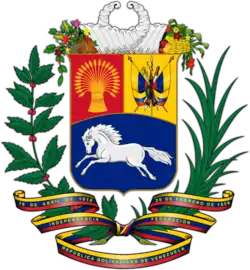
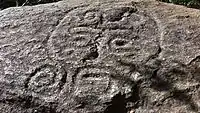
.jpg.webp)

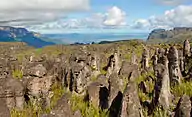
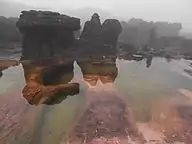

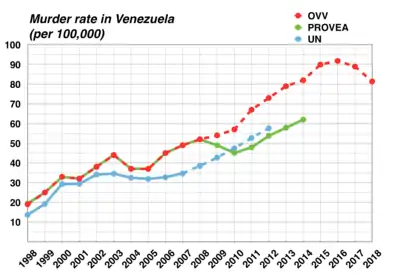
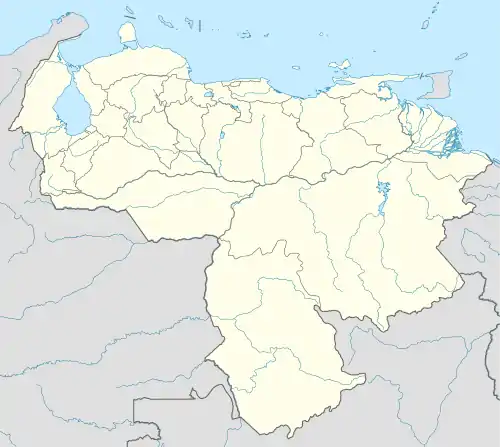
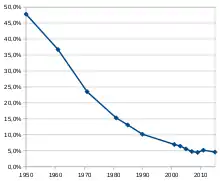
.svg.png.webp)

